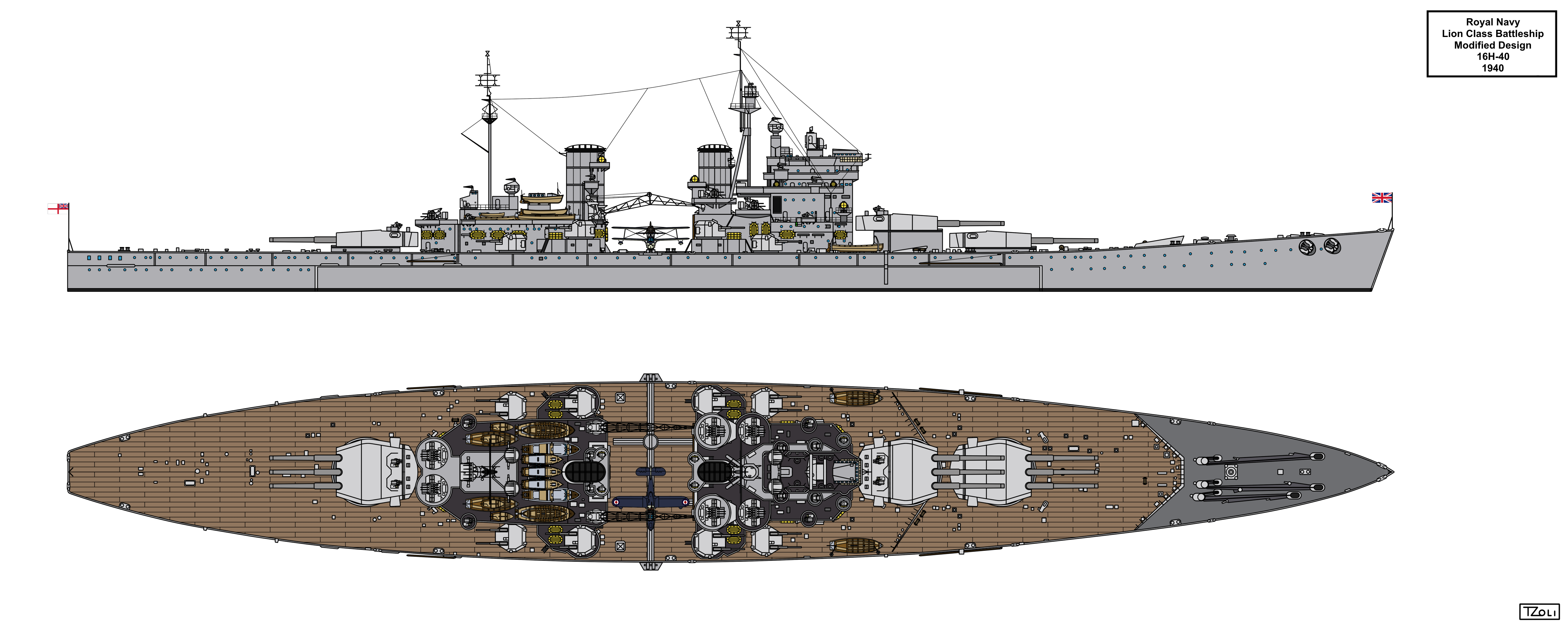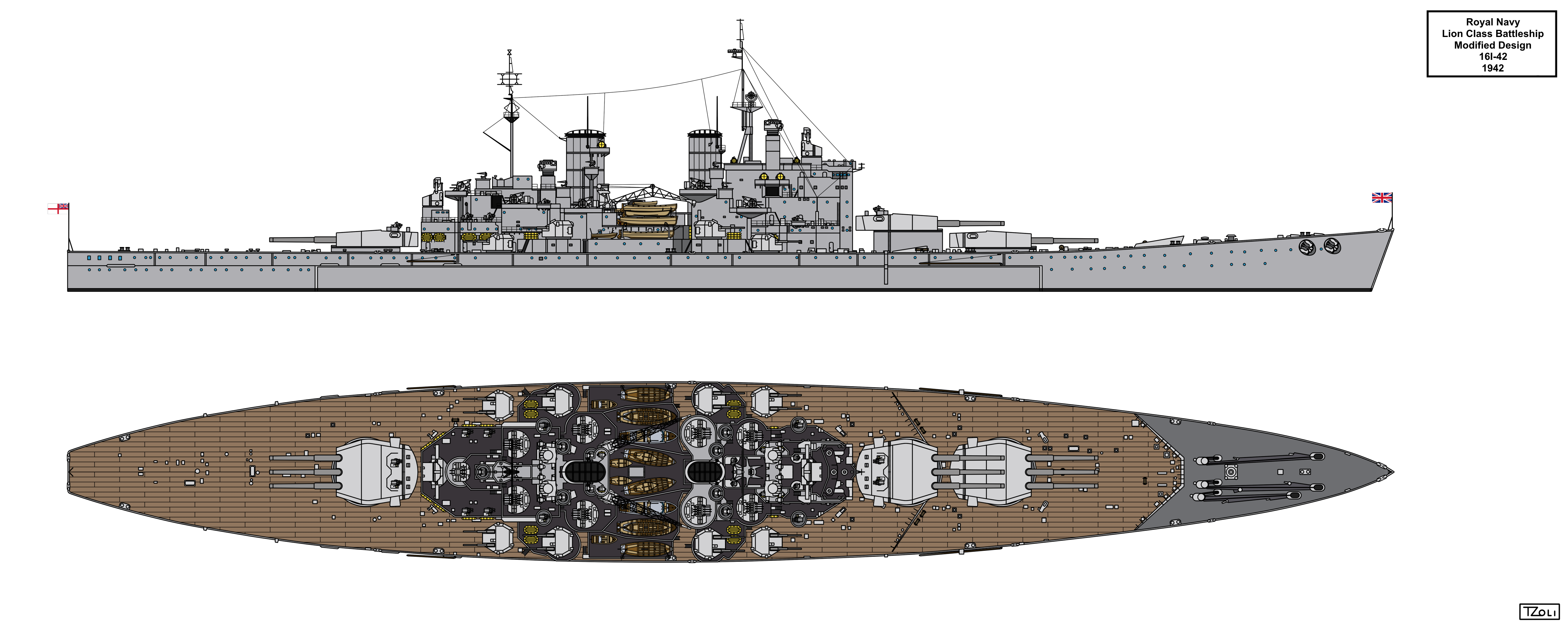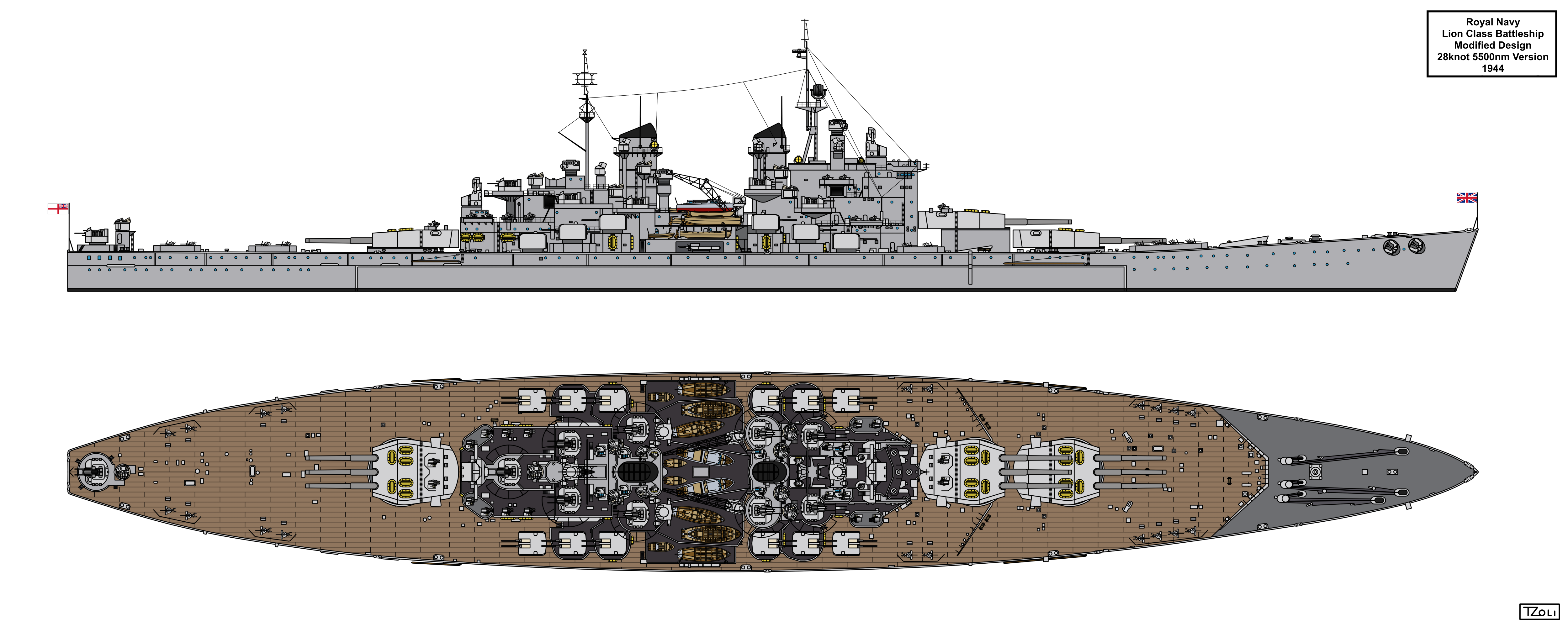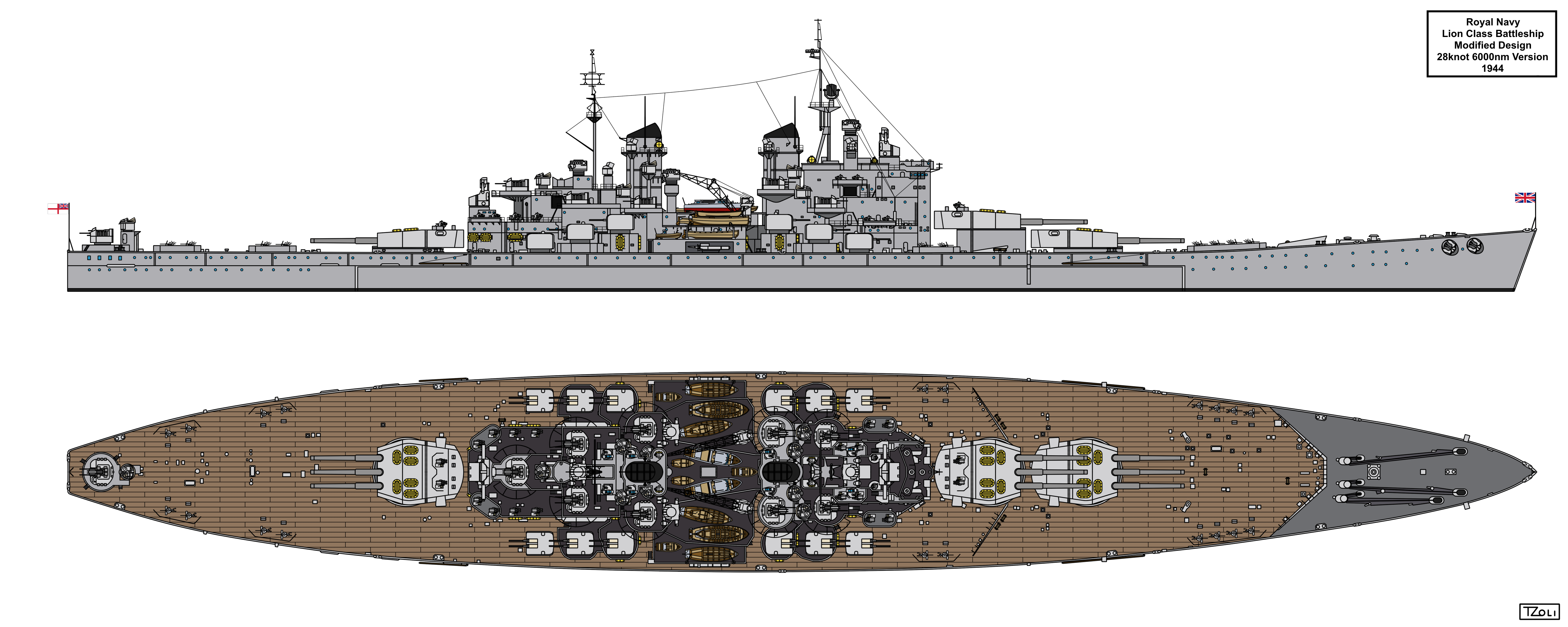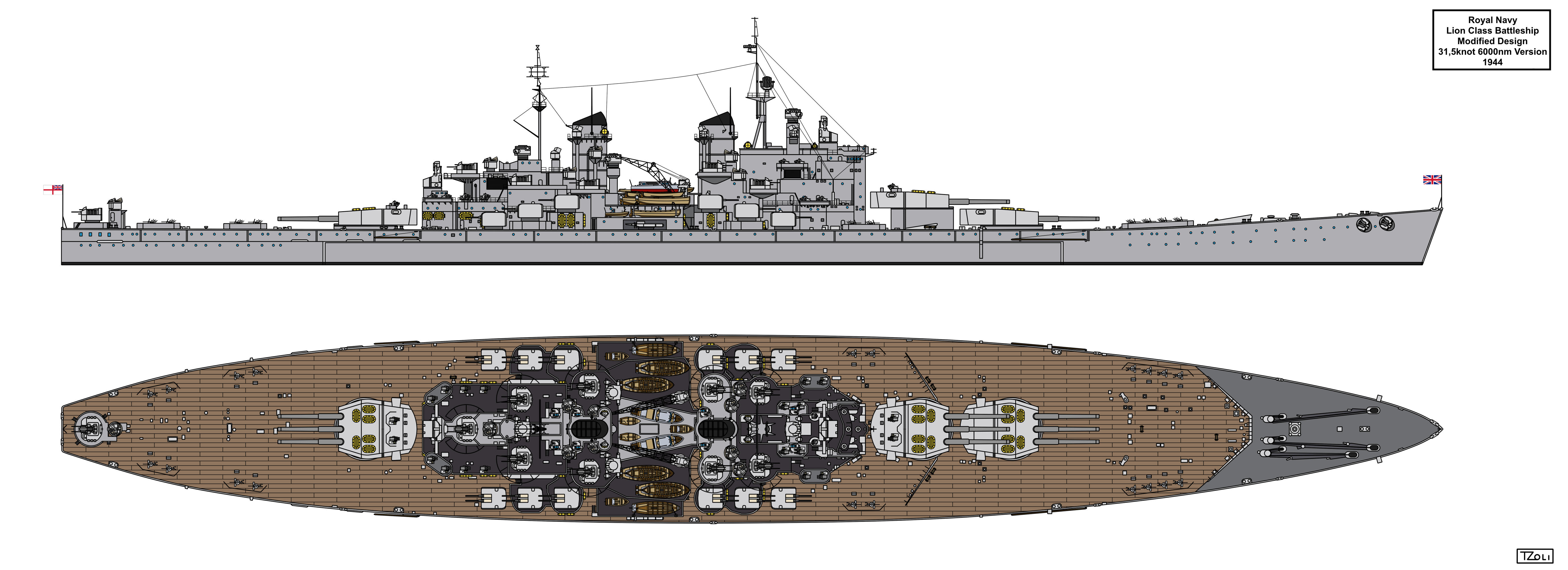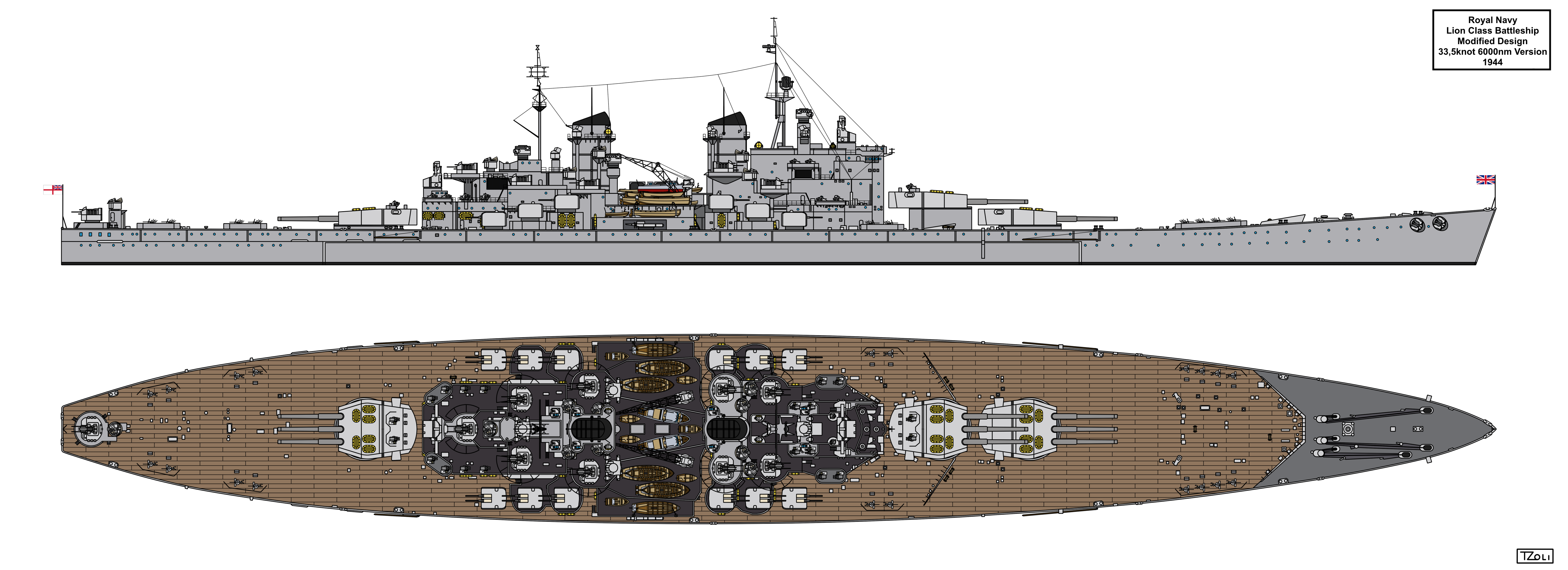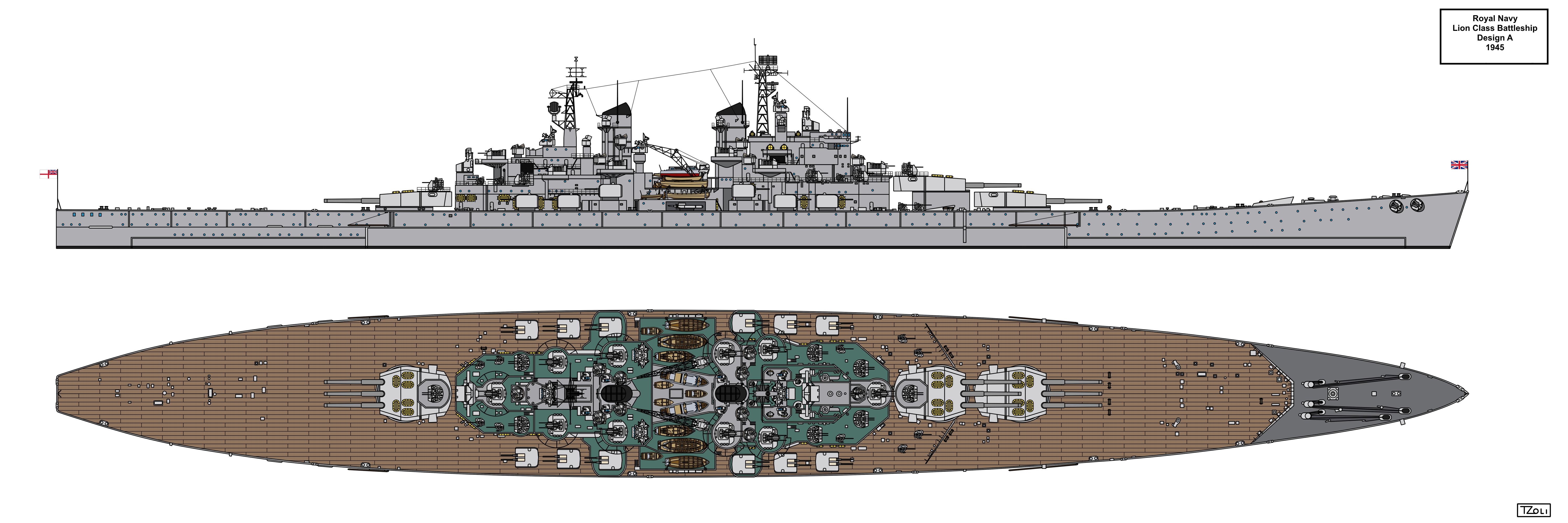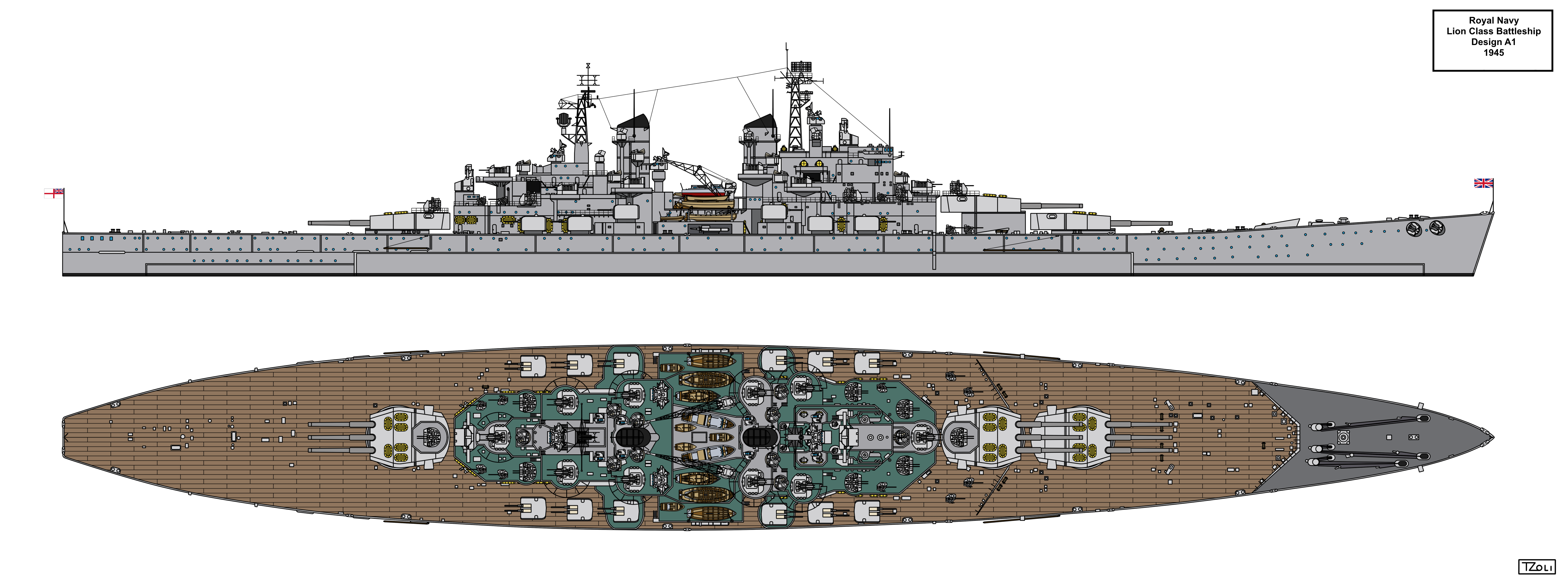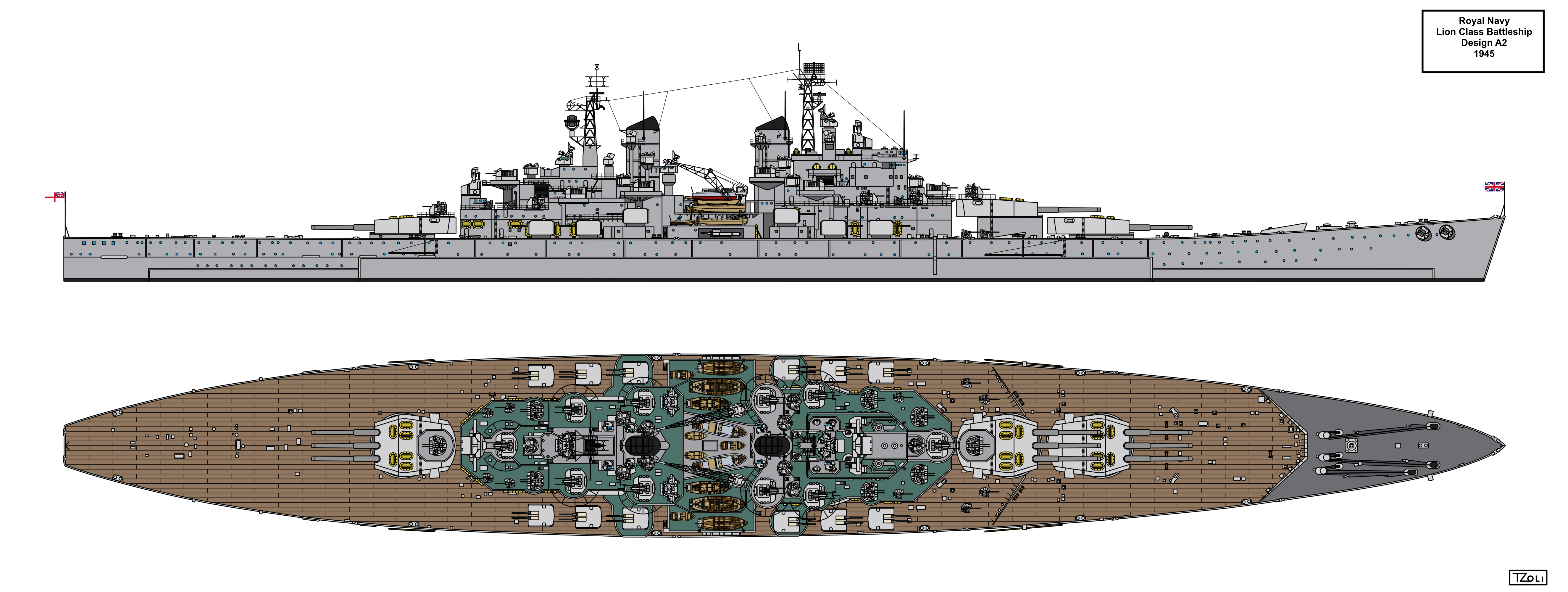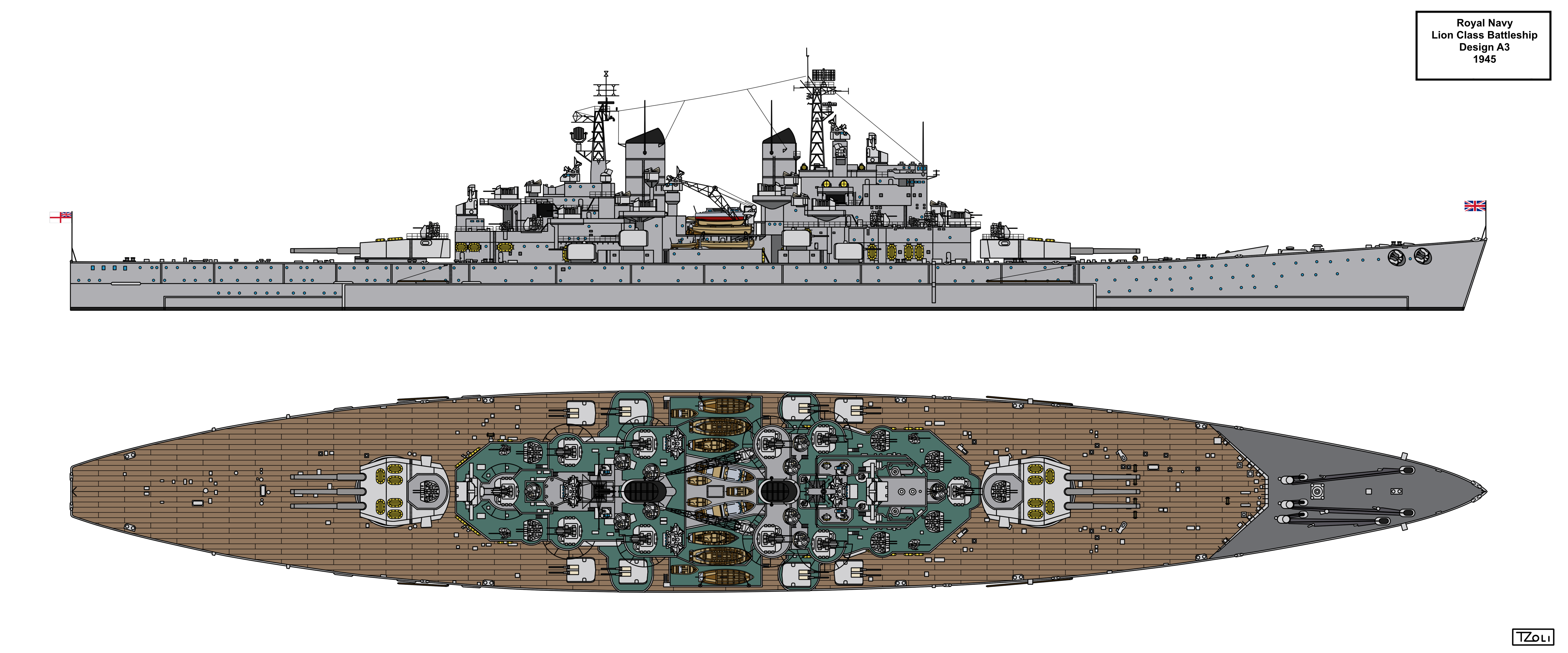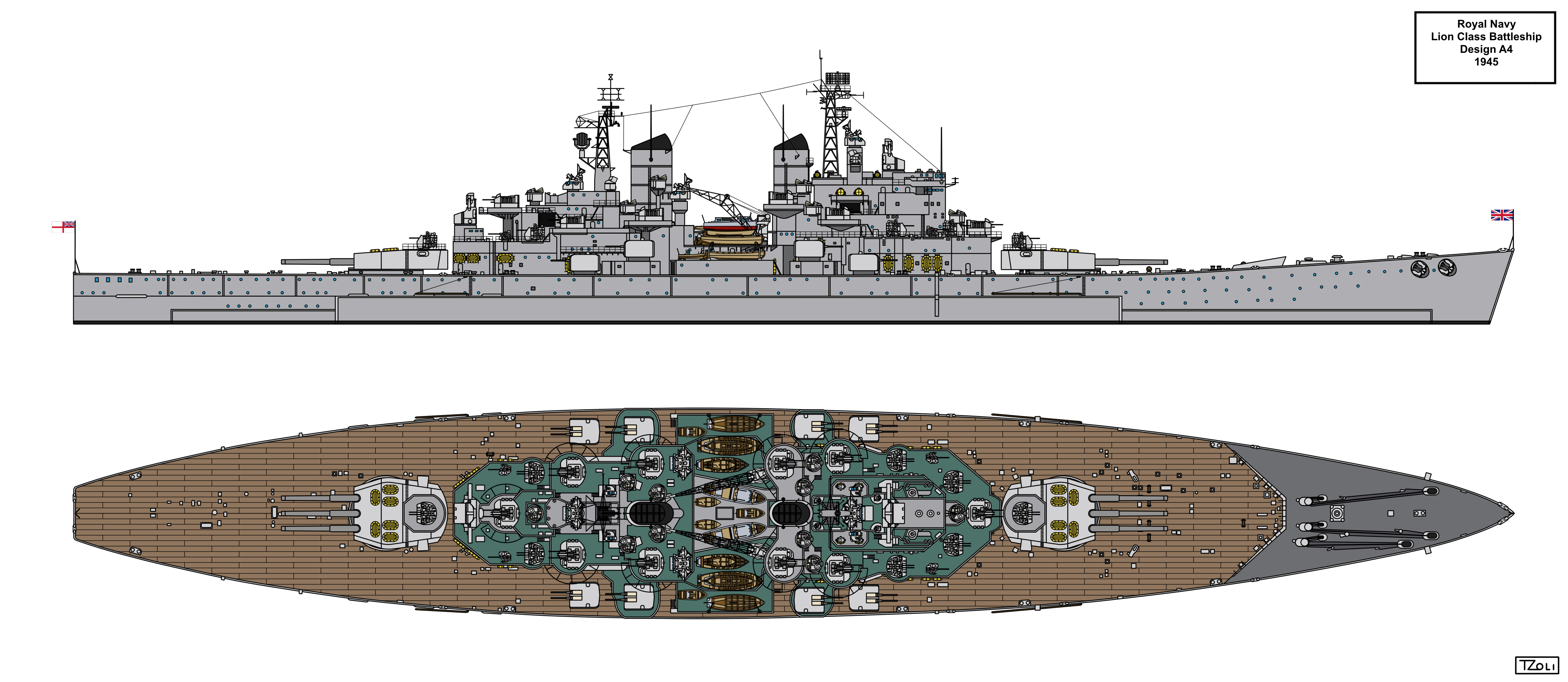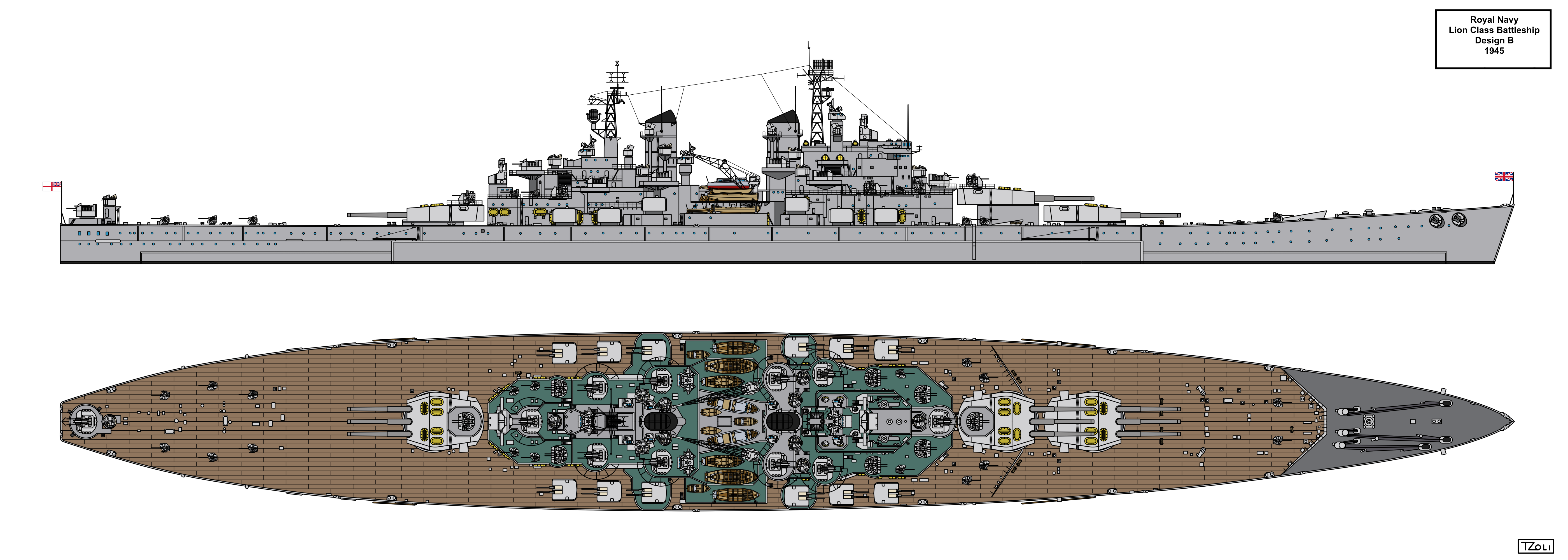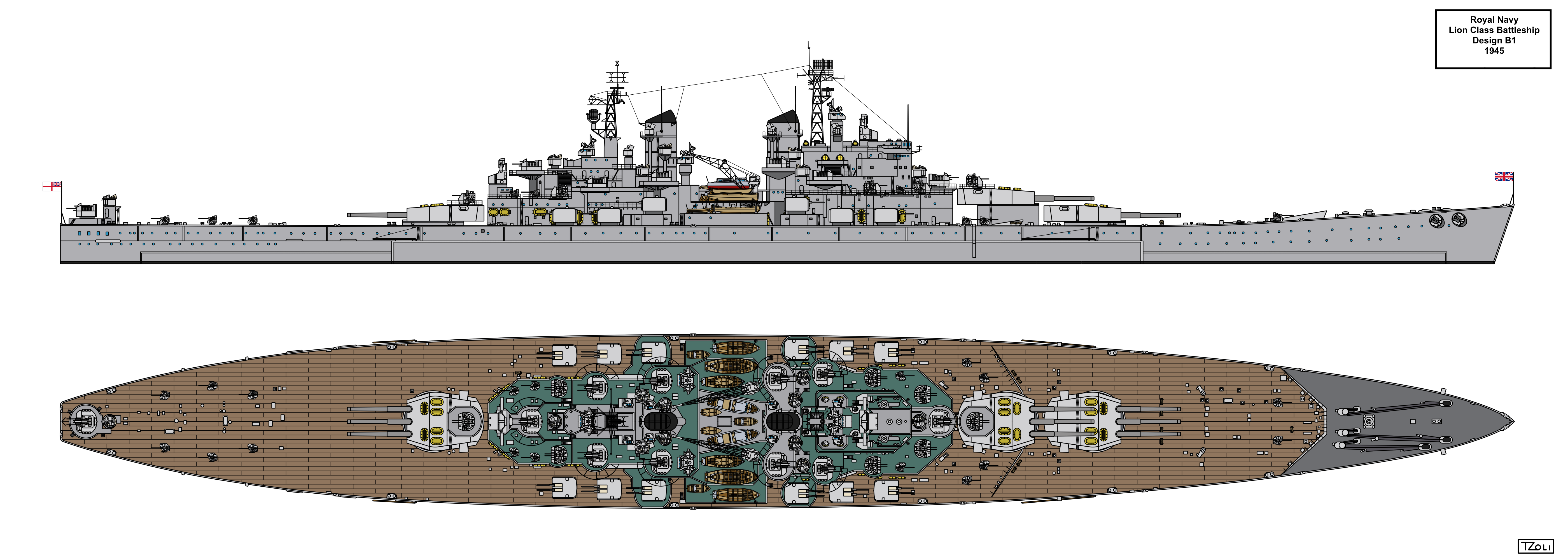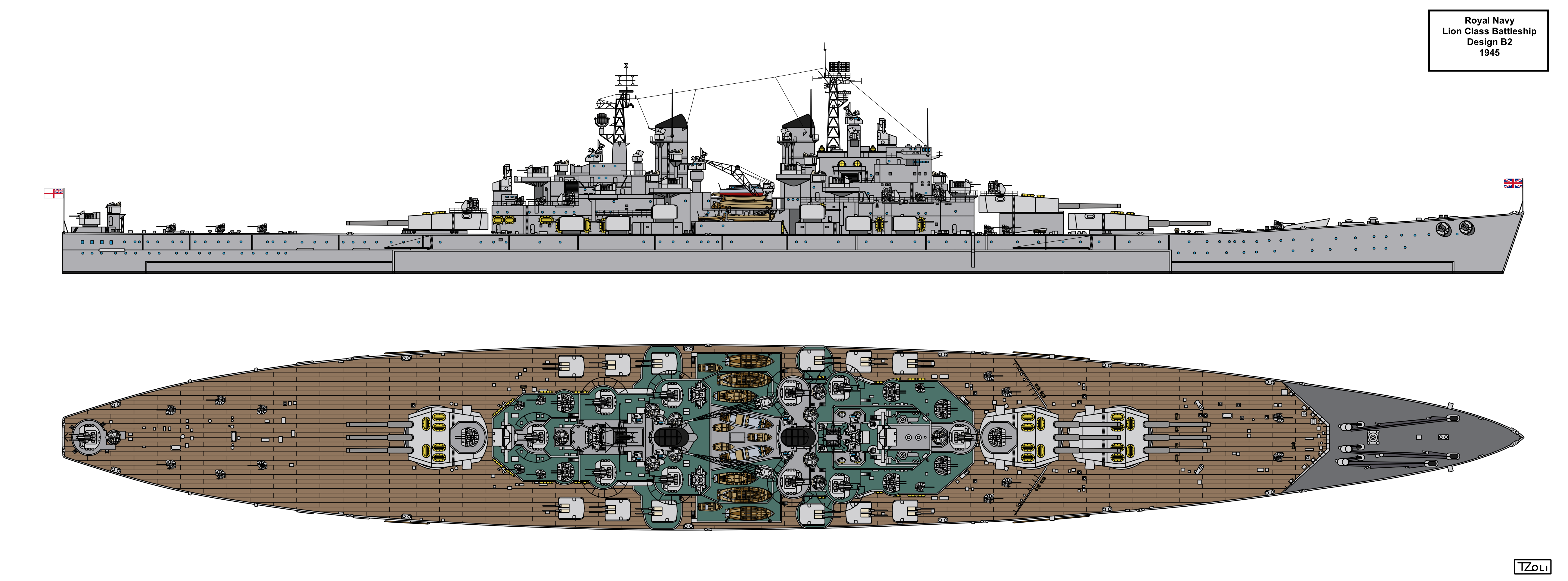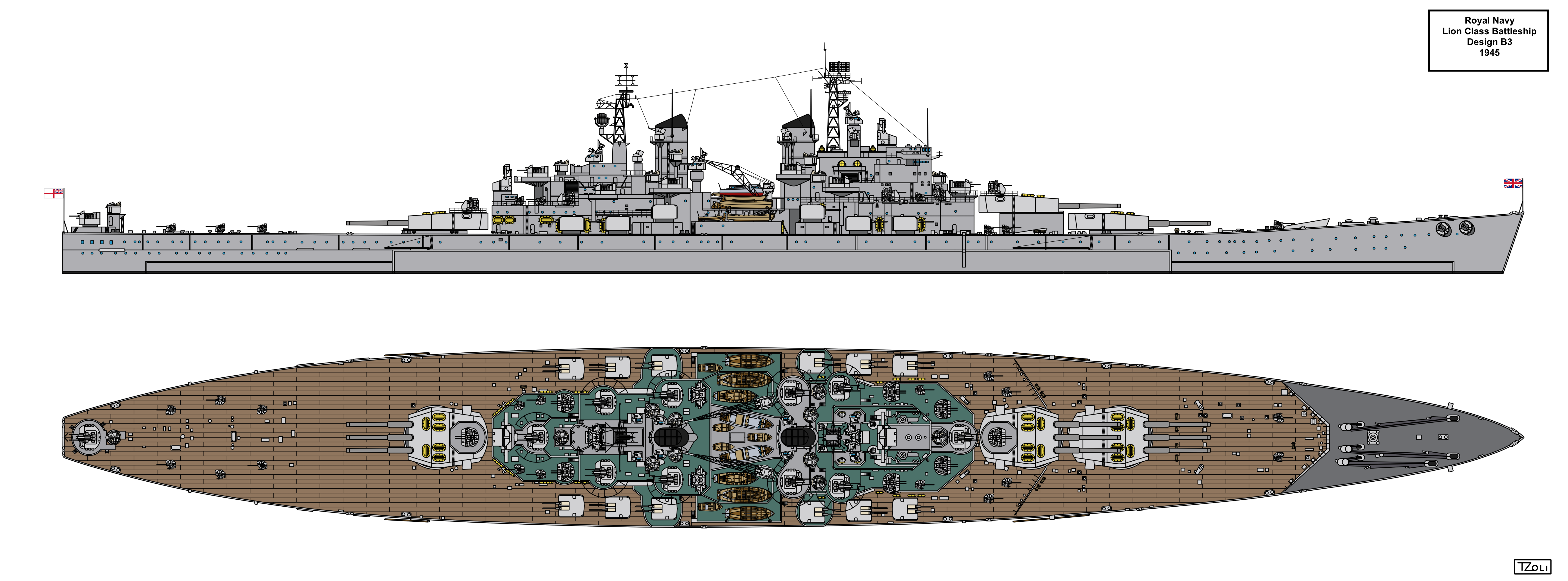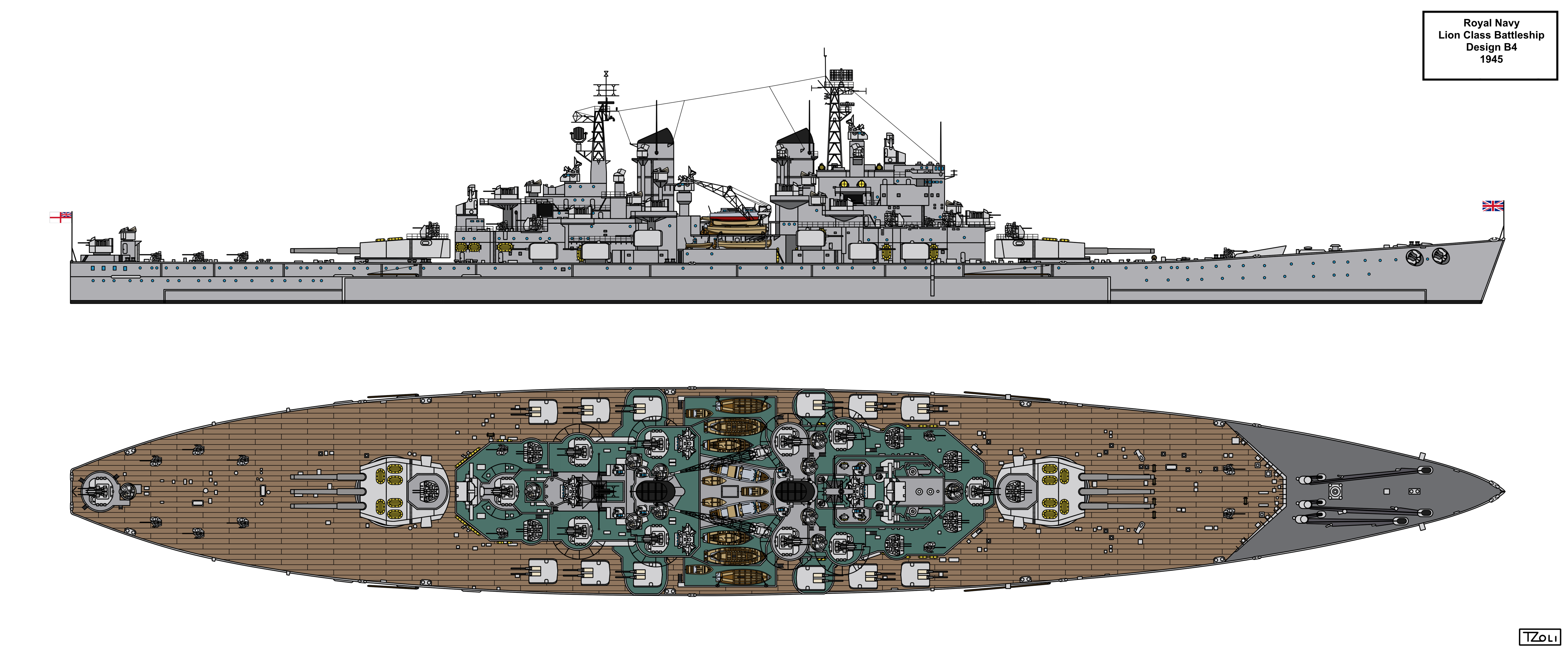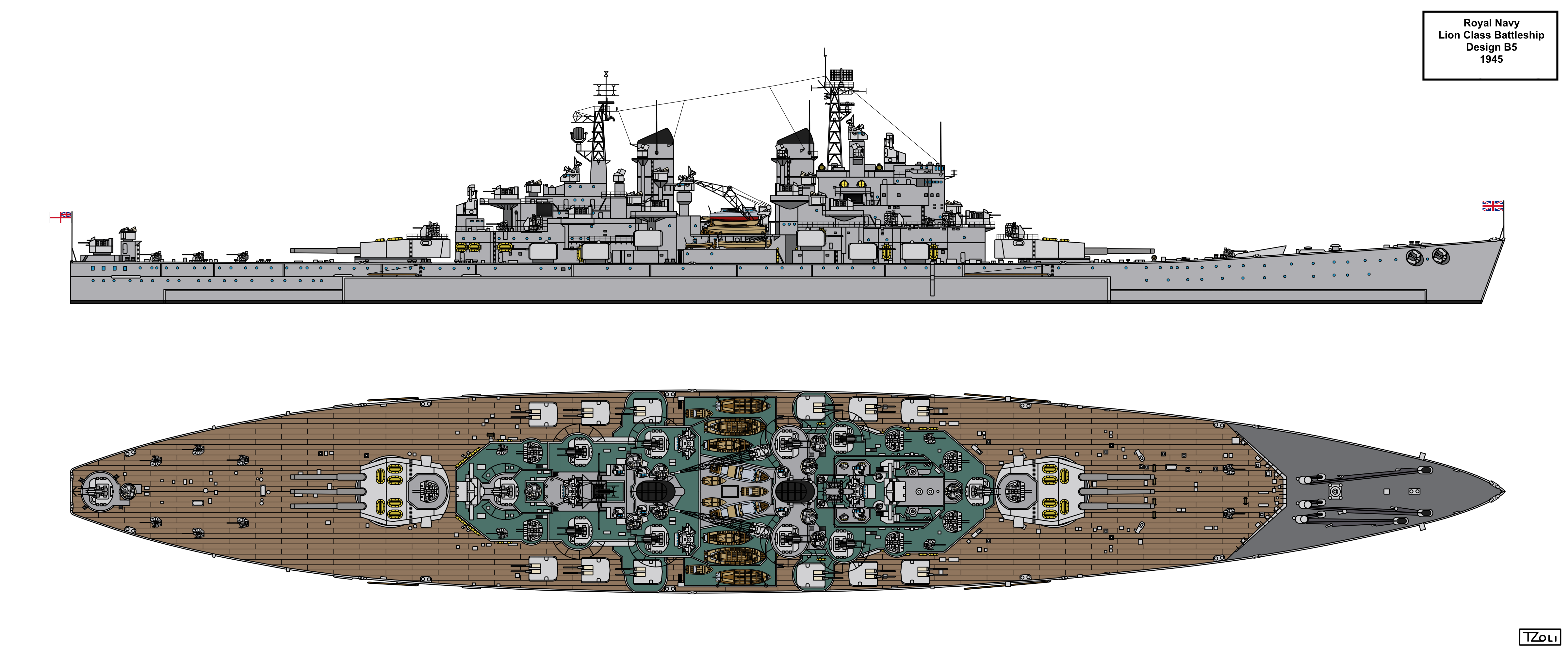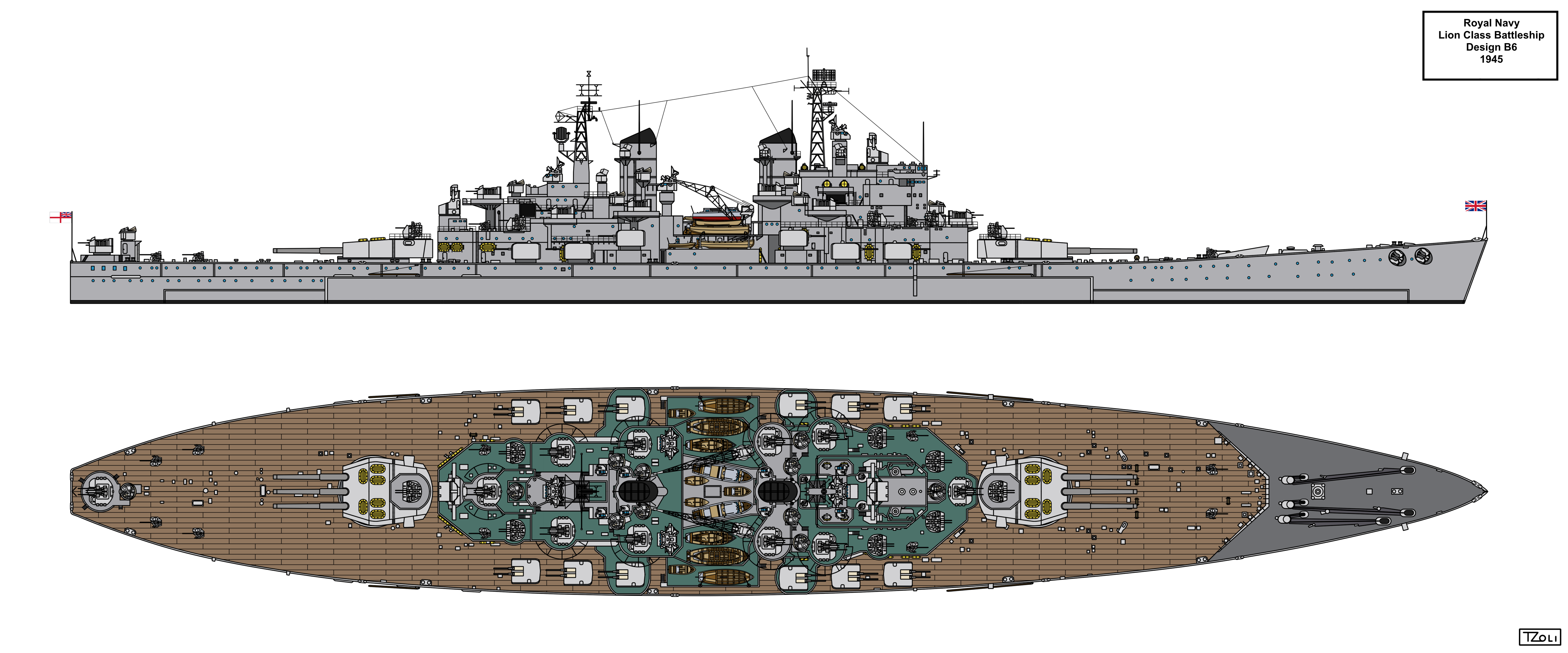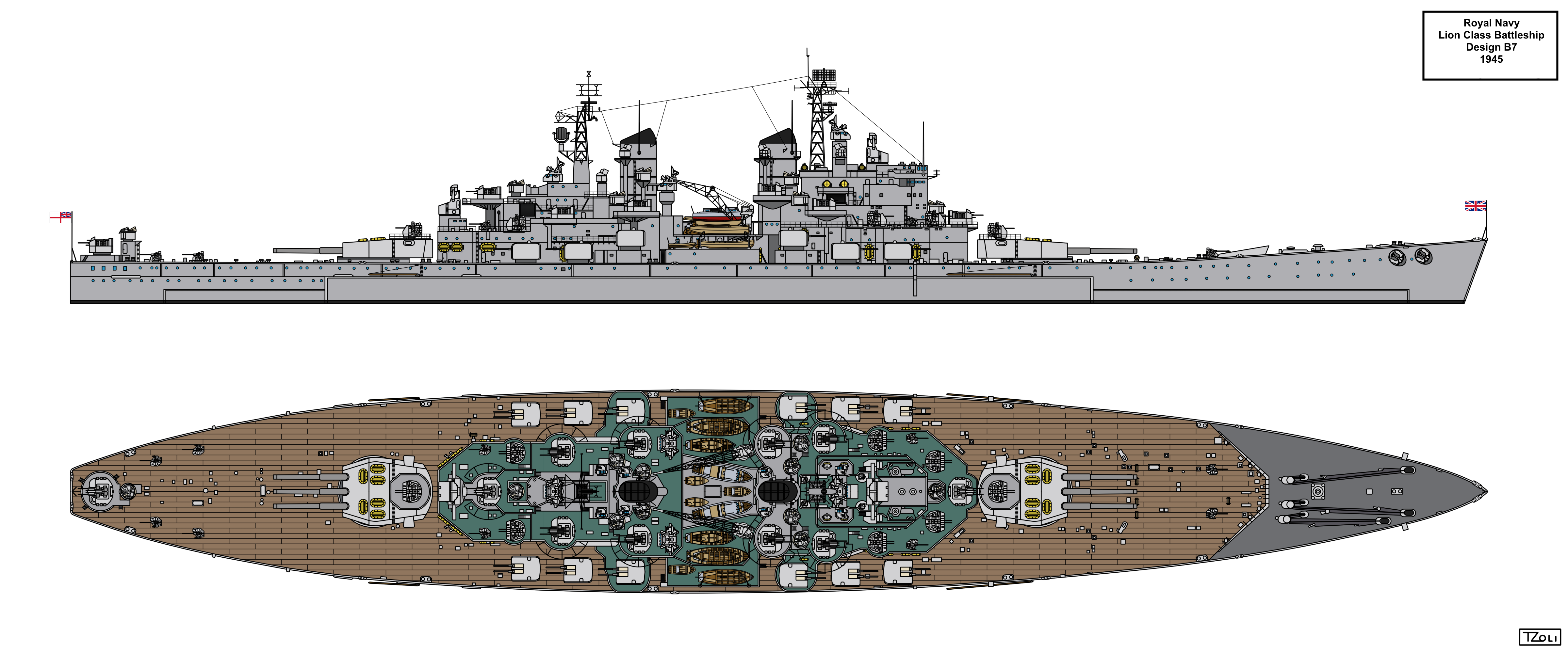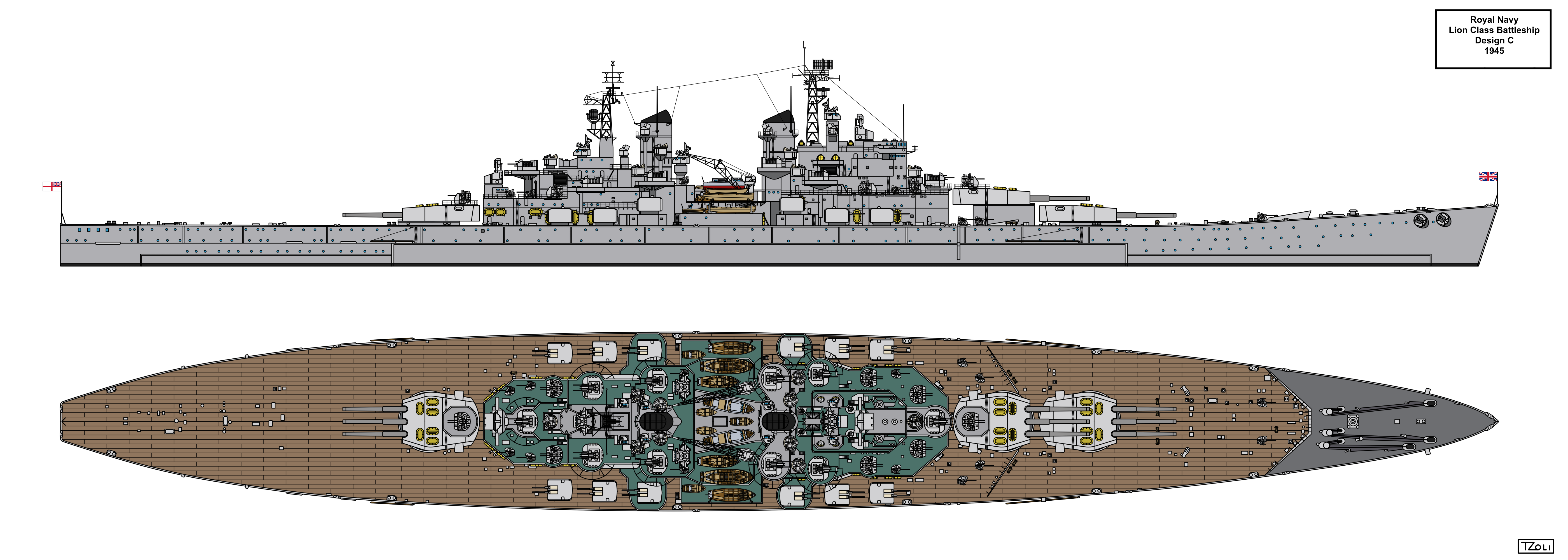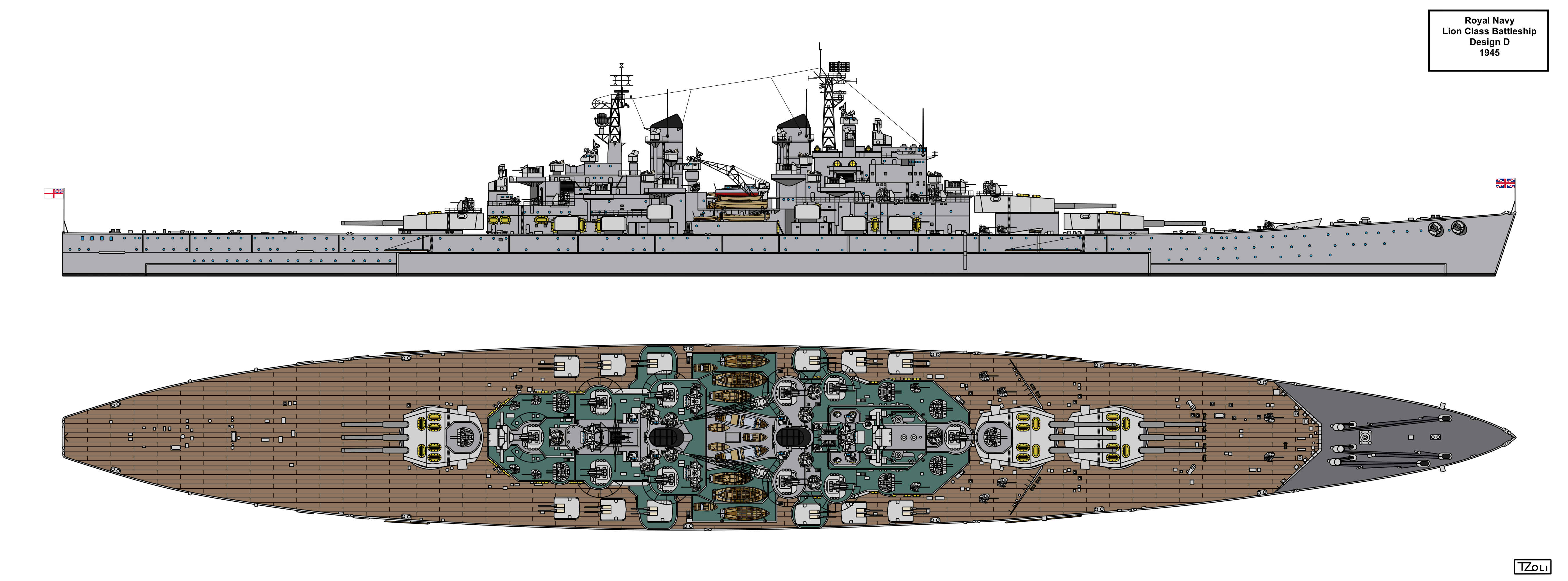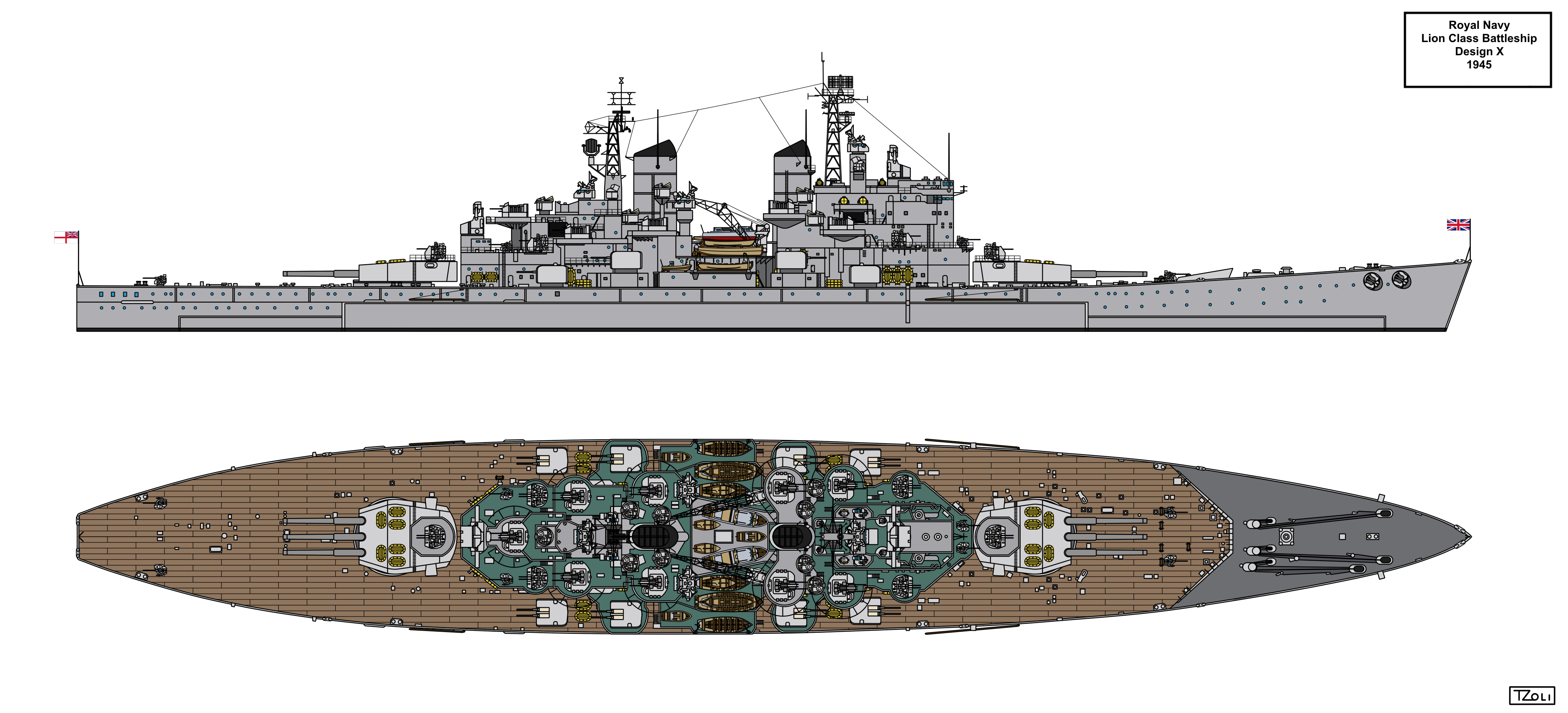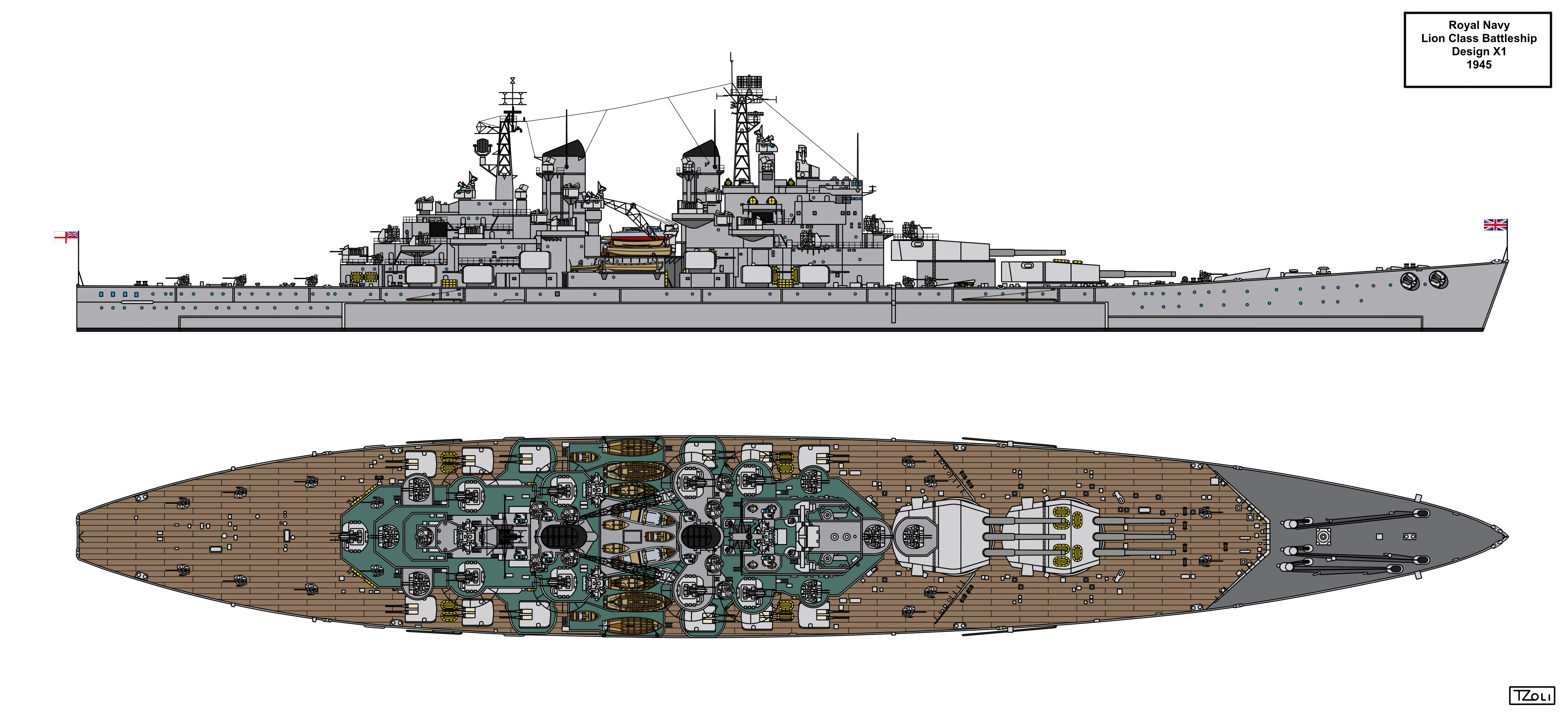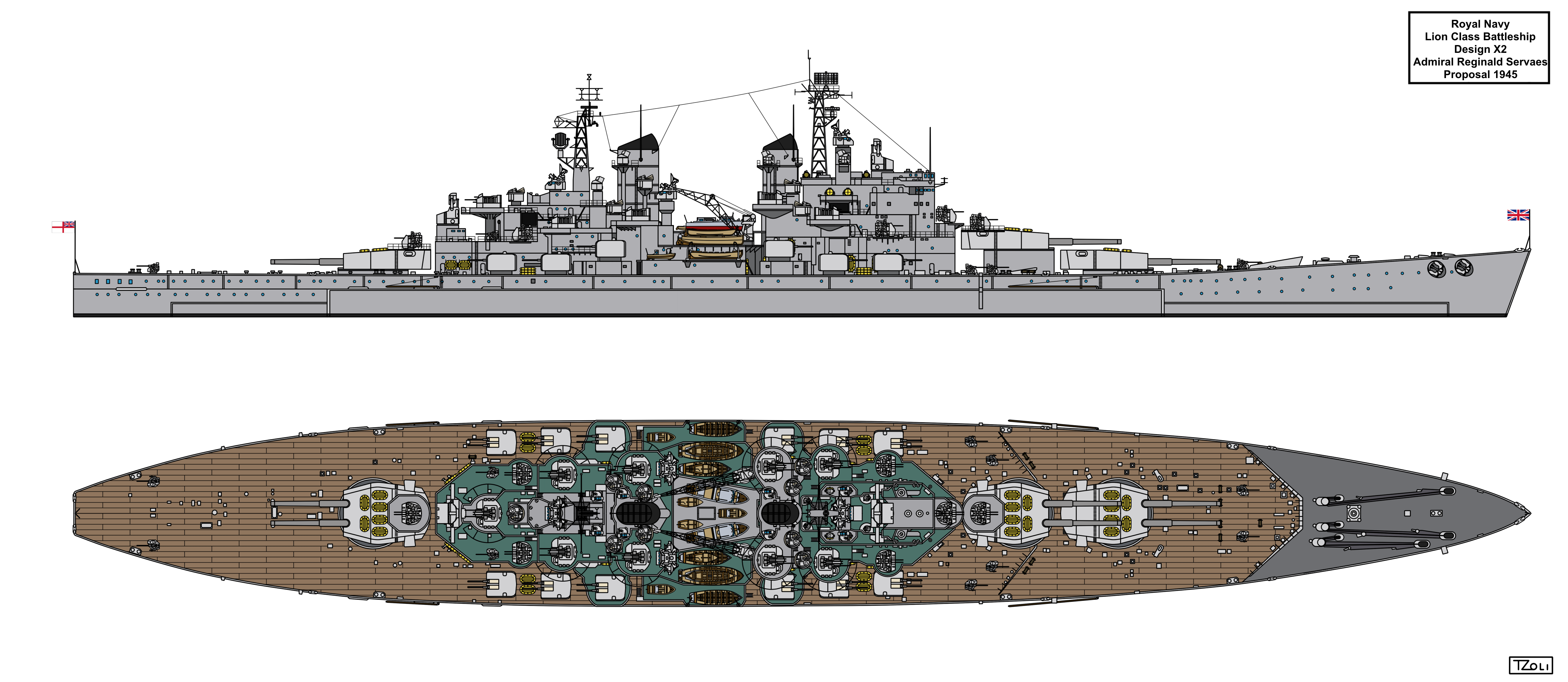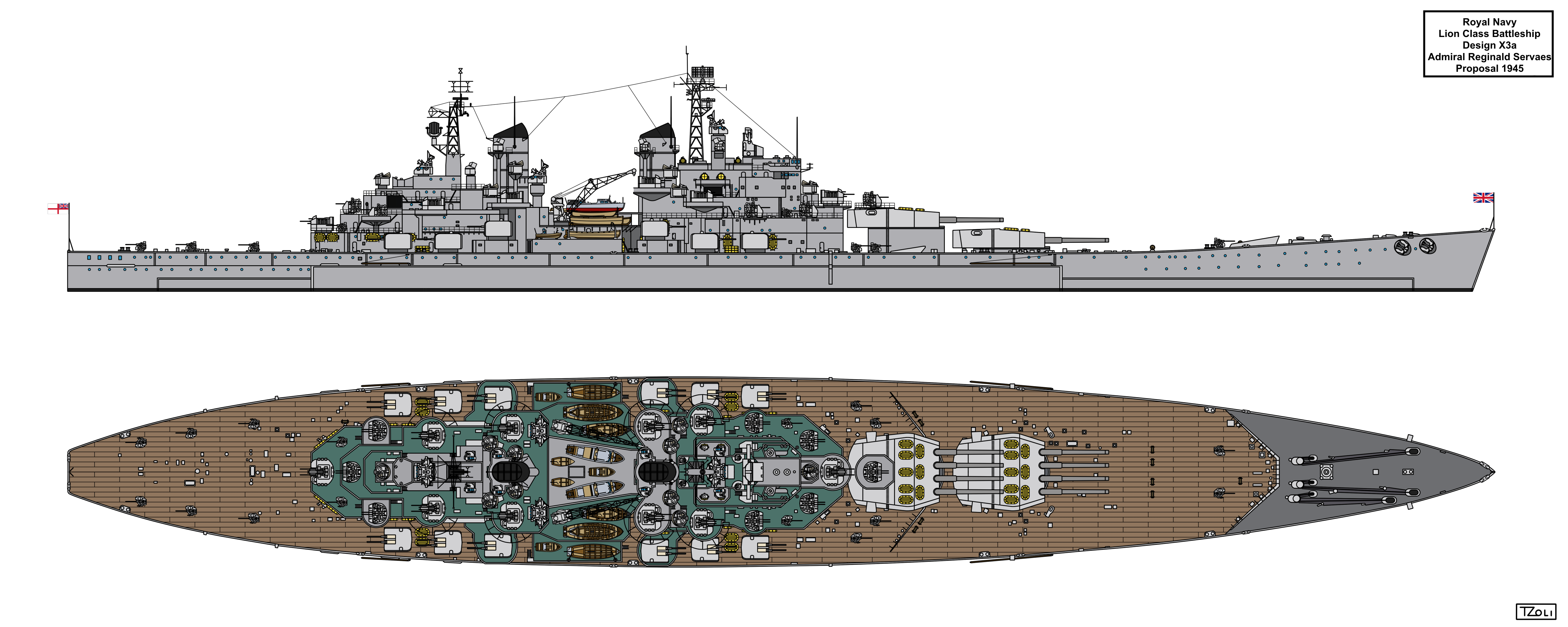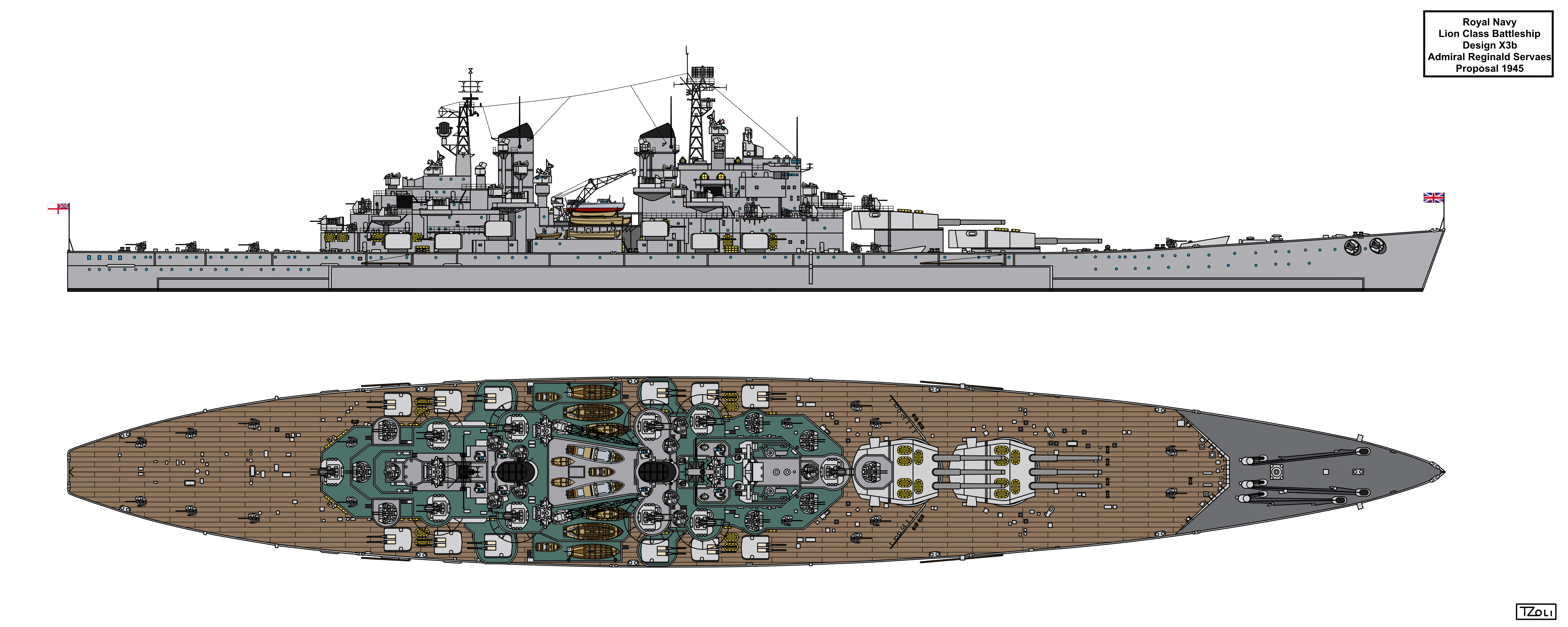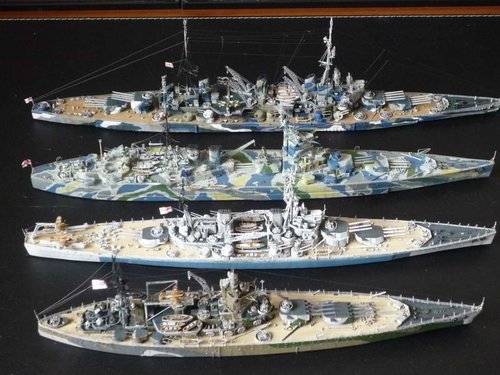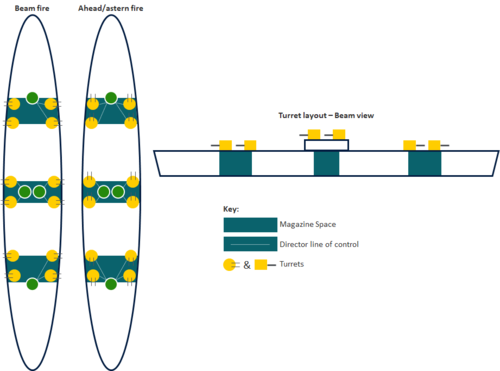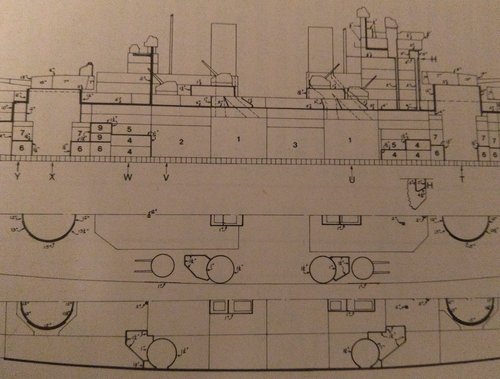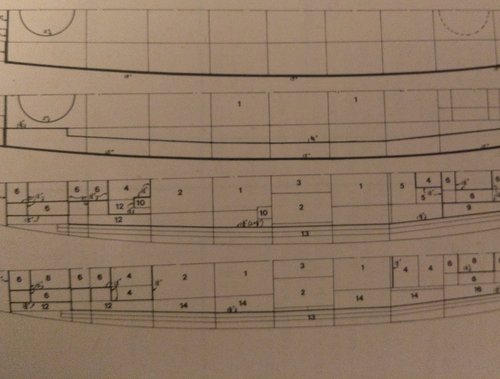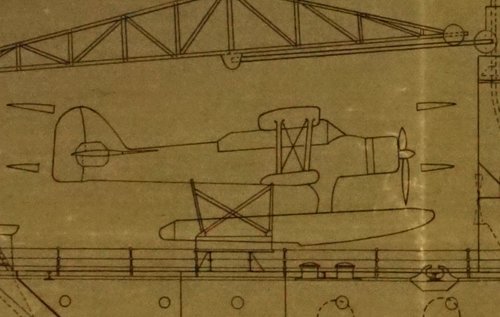- Joined
- 1 February 2011
- Messages
- 2,941
- Reaction score
- 3,624
The Royal Navy's second 16" armed battleships history was a long and bumpy road of large number of designs and the inability on the Admiralty's side to actually start and continue it's work on them or choose a design to produce.
First I present the 1938 designs:
Design 14A-38

This is the first actual sketch design which led to the Lion class Battleships. Created in late 1937 the earlier proposals were mostly only studies and I could not find data about them except 5 variants considered after KGV: 3x4 14", 3x3 15" and 4x2, 2x3 or 3x3 16" but serious calculations and drawings appeared only from the 2nd half of 1937 and early 1938.
The first designs are strictly modified KGV's to abide the 2nd LNT so on around 35.000tons standard displacement which partly a result to finish the last 3 King George V class battleships to a modified design (3 quad 14" was preferred for them) but eventually evolved into the long postponed and cancelled Lion class battleships.
This particular design is a quad armed 14" gun version of the King George V class, but to remain within the standards of the previous class's tonnage the sacrifice of all aircraft arrangements as well as a pair of 5,25" turrets was necessary to provide enough tonnage for a 3rd quad 14" turret with slightly reduced armour thicknesses on the hull.
The design had these characteristics:
Dimensions: 213,4m(pp), 225,56m(wl), 227,1m (oa) x 31,4m x 9,3m (same as KGV)
Displacement: 35.450tons (Standard), 41.300tons (full load)
Engines: 120.000shp Parsons Steam Turbines
Speed: 53km/h (28knots)
Range: 26.000km at 18-19km/h (14000nm at 10knots)
Armour: 124mm, Deck over machinery and 149mm over magazines, 348mm Belt over machinery and 374mm over magazines.
Armaments:
3x4 14"/45 (356mm/45) BL Mk VII Cannons,
6x2 5,25"/50 (133mm/50) QF Mk I DP-AA Guns,
4x8 40mm/39 Pom-Pom AA Guns
possible 2-4-8x4 12,7mm MG Mk III AA Guns
Sensor suite:
1x Type 79 Air-search Radar on the aft mast
1x Type 273 Surface search Radar on the mainmast above the forward secondary director
2x Type 281 Air-warning Radar on top of the aft mast
4x Type 282 Fire-control Radar sets one for each Pom-Pom director
3x Type 284 Fire-control Radar on the main armament director/rangefinders
4x Type 285 Fire-control Radar sets one for each secondary armament director/rangefinder
2x Type 290 Air-warning Radar on top of the masts
Design 16A-38

Roughly at the same time the 3 quad 14" armed design was sketched up and worked, a similar design too was proposed but with new triple 16" gun turrets (the 16" armed KGV preliminaries of 1935 would had used the same guns as Nelson's 16") squeezed in the same hull and on a very similar tonnage. To remain in the 35.000tons limit of the 2nd LNT, for standard displacement less ammo was calculated which saved precious tons (there was enough space for a full set of ammo) and similarly to the 14A-37 variant, aircraft facilities and one pair of 5,25 DP-AA gun turrets had to be sacrificed.
The designs had these characteristics:
Dimensions: 213,4m(pp), 225,56m(wl), 227,1m (oa) x 31,4m x 9,3m (same as KGV)
Displacement: 35.540tons (Standard), 41.400tons (full load)
Engines: 110.000shp Parsons Steam Turbines
Speed: 52km/h (28knots)
Range: 26.000km at 18-19km/h (14000nm at 10knots)
Armour: 124mm, Deck over machinery and 149mm over magazines, 348mm Belt over machinery and 374mm over magazines.
Armaments:
3x3 16"/45 (406mm/45) BL Mk II Cannons,
6x2 5,25"/50 (133mm/50) QF Mk I DP-AA Guns,
4x8 40mm/39 Pom-Pom AA Guns
possible 2-4-8x4 12,7mm MG Mk III AA Guns
Sensor suite:
1x Type 79 Air-search Radar on the aft mast
1x Type 273 Surface search Radar on the mainmast above the forward secondary director
2x Type 281 Air-warning Radar on top of the aft mast
4x Type 282 Fire-control Radar sets one for each Pom-Pom director
3x Type 284 Fire-control Radar on the main armament director/rangefinders
4x Type 285 Fire-control Radar sets one for each secondary armament director/rangefinder
2x Type 290 Air-warning Radar on top of the masts
Design 16B-38

While the designs 14A-37 and 16A-38 was born in late 1937 and late 1937 early 1938 respectively, Design 16B-38 was an early 1938 design, a slight modification of the A version having stated KGV style turbines (with sources differ about increased speed by a knot or not) and 100tons heavier implying a larger engine output. Visually no different then the A-37 version, but I've re arranged the AA armament to make it look somewhat different.
The designs had these characteristics:
Dimensions: 213,4m(pp), 225,56m(wl), 227,1m (oa) x 31,4m x 9,3m (same as KGV)
Displacement: 35.640tons (Standard), 41.500tons (full load)
Engines: 120.000shp Parsons Steam Turbines
Speed: 53km/h (28,5-28,75knots)
Range: 26.000km at 18-19km/h (14000nm at 10knots)
Armour: 124mm, Deck over machinery and 149mm over magazines, 348mm Belt over machinery and 374mm over magazines.
Armaments:
3x3 16"/45 (406mm/45) BL Mk II Cannons,
6x2 5,25"/50 (133mm/50) QF Mk I DP-AA Guns,
4x8 40mm/39 Pom-Pom AA Guns
possible 2-4-8x4 12,7mm MG Mk III AA Guns
Sensor suite:
1x Type 79 Air-search Radar on the aft mast
1x Type 273 Surface search Radar on the mainmast above the forward secondary director
2x Type 281 Air-warning Radar on top of the aft mast
4x Type 282 Fire-control Radar sets one for each Pom-Pom director
3x Type 284 Fire-control Radar on the main armament director/rangefinders
4x Type 285 Fire-control Radar sets one for each secondary armament director/rangefinder
2x Type 290 Air-warning Radar on top of the masts
Design 16C-38

After the 3 designs of the post KGV battleships produced DNC (Director of Naval Constructions) asked to whatever to possible to mount catapults and 2 aircraft on these designs.
Calculations shown that all the aft 5,25" DP-AA guns had to be sacrificed and standard ammo coverage reduced to save enough tonnage to mount the necessary equipment for aircraft handling. What is also unique in the design that the hangers to be located in the after superstructure rather in the middle one (Actually the King George V class battleships had 3 superstructures: The forward one containing the bridge, separated by a short passage from the middle one originally held the hangers and first funnel, and the aft one containing the 2nd funnel and boat storage spaces). The design was not satisfactory enough as it was quite crowded and many of the boats were prone to blast damage from the aft 3rd 16" gun turret when firing! Also the reduced number of Dual Purpose turrets meant reduced long range AA as well as anti destroyer fighting capabilities, especially in night battle. Controller thought if an extra 160tons could be saved somehow (Most likely by altering the protective deck scheme by lowering the armour deck) a pair of 5,25 turrets could be restored, this alternative version would mount all such turrets forward with 2nd superfiring over the other two, but this not only group all secondary guns close to each other and thus danger them to being disable by a single hit but because they had to be moved more forward that the blast of the 2nd triple 16" gun turret would seriously damage the 1st 5,25" mounting!
The designs had these characteristics:
Dimensions: 213,4m(pp), 225,56m(wl), 227,1m (oa) x 31,4m x 9,3m (same as KGV)
Displacement: 35.500tons (Standard), 41.350tons (full load)
Engines: 110.000shp Parsons Steam Turbines
Speed: 52km/h (28knots)
Range: 26.000km at 18-19km/h (14000nm at 10knots)
Armour: 124mm, Deck over machinery and 149mm over magazines, 348mm Belt over machinery and 374mm over magazines.
Armaments:
3x3 16"/45 (406mm/45) BL Mk II Cannons,
4x2 5,25"/50 (133mm/50) QF Mk I DP-AA Guns,
4x8 40mm/39 Pom-Pom AA Guns
possible 2-4-8x4 12,7mm MG Mk III AA Guns.
2x Floatplanes (I've chosen Supermarine Sea Otter)
Sensor suite:
1x Type 79 Air-search Radar on the aft mast
1x Type 273 Surface search Radar on the mainmast above the forward secondary director
2x Type 281 Air-warning Radar on top of the aft mast
4x Type 282 Fire-control Radar sets one for each Pom-Pom director
3x Type 284 Fire-control Radar on the main armament director/rangefinders
5x Type 285 Fire-control Radar sets one for each secondary armament director/rangefinder
2x Type 290 Air-warning Radar on top of the masts
Design 16D-38

After the previous series was done the Admirality discussed them, the lowered deck armour level as well as the diamond arrangement of he pom-pom AA guns was discarded, also the eventual lifting of the 35.000ton treaty limited invoked by the retire of the Japanese, caused the escalator cause to be fully applied. Resulting in larger warship designs and soon led to the final Lion class battleship design. At first the RN wanted to stay at 40.000tons to keep cost down but soon realised that a balanced 16" armed battleship was better achieved on 45.000tons standard displacement.
This D variant was faster 30knot version of the previous series with all the aircraft, catapult and DP-AA guns retained which together with the increased speed meant a much larger warship as well.
Later a further enlarged version with 4 turrets are proposed designated 16E-38 featuring an even larger hull but a well balanced ship.
The designs had these characteristics:
Dimensions: 250m(wl) x 32,31m x 10,16m
Displacement: 42.500tons (Standard), 48.400tons (full load)
Engines: 150.000shp Parsons Steam Turbines
Speed: 57km/h (30knots)
Range: 26.000km at 18-19km/h (14000nm at 10knots)
Armour: 124mm, Deck over machinery and 149mm over magazines, 348mm Belt over machinery and 374mm over magazines.
Armaments:
3x3 16"/45 (406mm/45) BL Mk II Cannons,
8x2 5,25"/50 (133mm/50) QF Mk I DP-AA Guns,
4x8 40mm/39 Pom-Pom AA Guns
possible 2-4-8x4 12,7mm MG Mk III AA Guns.
2-4x Floatplanes (I've chosen Supermarine Sea Otter)
Sensor suite:
1x Type 79 Air-search Radar on the aft mast
1x Type 273 Surface search Radar on the mainmast above the forward secondary director
2x Type 281 Air-warning Radar on top of the aft mast
4x Type 282 Fire-control Radar sets one for each Pom-Pom director
3x Type 284 Fire-control Radar on the main armament director/rangefinders
5x Type 285 Fire-control Radar sets one for each secondary armament director/rangefinder
2x Type 290 Air-warning Radar on top of the masts
Design 16E-38

While the previous version was a faster ship taking into account the extra displacement allowed by the escalator clause of the 2nd London Naval Treaty after Japan left it, the E variant was introduced a 4th triple turret increasing the firepower of the design by 25%! Armour remained the same with the same hull form introduced in the D version which helped maintain speed despite the increased displacement. even so the the extra tonnage brought by the 4th turret as well the longer armour belt meant a slower warship altogether, still the admiralty preferred this design for obvious reasons!
In the end it is essentially a British Montana and altogether the 2nd such design of the Royal Navy to mount 12x 16" cannons (the first one was a modified N3 design with 4x3 16" rather 3x3 18" similar in layout to the M2 design both from the 1920's)
The designs had these characteristics:
Dimensions: 259,08m(wl) x 33,53m x 10,72m
Displacement: 48.500tons (Standard), 55.000tons (full load)
Engines: 120.000shp Parsons Steam Turbines
Speed: 48-50km/h (26-27knots)
Range: 26.000km at 18-19km/h (14000nm at 10knots)
Armour: 124mm, Deck over machinery and 149mm over magazines, 348mm Belt over machinery and 374mm over magazines.
Armaments:
4x3 16"/45 (406mm/45) BL Mk II Cannons,
8x2 5,25"/50 (133mm/50) QF Mk I DP-AA Guns,
4x8 40mm/39 Pom-Pom AA Guns
possible 2-4-8x4 12,7mm MG Mk III AA Guns.
2-4x Floatplanes (I've chosen Supermarine Sea Otter)
Sensor suite:
1x Type 79 Air-search Radar on the aft mast
1x Type 273 Surface search Radar on the mainmast above the forward secondary director
2x Type 281 Air-warning Radar on top of the aft mast
4x Type 282 Fire-control Radar sets one for each Pom-Pom director
3x Type 284 Fire-control Radar on the main armament director/rangefinders
4x Type 285 Fire-control Radar sets one for each secondary armament director/rangefinder
2x Type 290 Air-warning Radar on top of the masts
Design 14B-38

The 14B variant was the logical step of the 14" armed battleship of the Royal Navy after the lifting of the 35.000tons displacement limit of the 2nd London Naval Treaty.
Based on the same hull as the 16D-38 design, this was (to my knowledge) the last 14" armed battleship study of the Royal navy and basically, if you will, can think of as a super King George V class, with improved armament and splinter protection together with a better speed more suited for the Royal Navy, basically as how the KGV should had been built from the first place!
I've chosen more of a Lion stlye superstructure look as well as 40mm Pom-Pom arrangement because this design was created around the same time the final Lion class layout approved.
The designs had these characteristics:
Dimensions: 250m(wl) x 32,31m x 10,16m
Displacement: 42.750tons (Standard), 48.500tons (full load)
Engines: 150.000shp Parsons Steam Turbines
Speed: 56-57km/h (30knots)
Range: 26.000km at 18-19km/h (14000nm at 10knots)
Armour: 124mm, Deck over machinery and 149mm over magazines, 348mm Belt over machinery and 374mm over magazines.
Armaments:
3x4 14"/45 (356mm/45) BL Mk VII Cannons,
8x2 5,25"/50 (133mm/50) QF Mk I DP-AA Guns,
6x8 40mm/39 Pom-Pom AA Guns
possible 2-4-8x4 12,7mm MG Mk III AA Guns.
2-4x Floatplanes (I've chosen Supermarine Sea Otter)
Sensor suite:
1x Type 79 Air-search Radar on the aft mast
1x Type 273 Surface search Radar on the mainmast above the forward secondary director
2x Type 281 Air-warning Radar on top of the aft mast
4x Type 282 Fire-control Radar sets one for each Pom-Pom director
4x Type 284 Fire-control Radar on the main armament director/rangefinders
4x Type 285 Fire-control Radar sets one for each secondary armament director/rangefinder
2x Type 290 Air-warning Radar on top of the masts
Design 16G-38

The G version is the last among the 30knotter of Lion pre variants with the same engine as the previous 14B-38 and 16D-38, but what is unique in this design that aircraft facilities was sacrificed for a rather questionable weapon for a battleship:
two quadruple 21" torpedo launchers!
Luckily the final 1938 Lion design discarded this option, on the other hand the idea returned in 1944/45 with the last Lion variants of the RN.
Sources (The two books which actually contains dimensions data as I have no chance of getting to the Brass foundry at Kew in the United Kingdom...) differ about the dimension of this design so I choose the same hull as the 14B-38 and 16D-38
The design had these characteristics:
Dimensions: sources differ: either 240,79 (pp) 250m(wl) or 259,18m (wl) x 32,31m x 9,45m
Displacement: 43.000tons (Standard), 49.000tons (full load)
Engines: 150.000shp Parsons Steam Turbines
Speed: 57km/h (30knots)
Range: 26.000km at 18-19km/h (14000nm at 10knots)
Armour: 124mm, Deck over machinery and 149mm over magazines, 348mm Belt over machinery and 374mm over magazines.
Armaments:
3x3 16"/45 (406mm/45) BL Mk II Cannons,
8x2 5,25"/50 (133mm/50) QF Mk I DP-AA Guns,
6x8 40mm/39 Pom-Pom AA Guns,
possible 2-4-8x4 12,7mm MG Mk III AA Guns,
2x4 21" (533mm) Torpedo Tubes.
Sensor suite:
1x Type 79 Air-search Radar on the aft mast
1x Type 273 Surface search Radar on the mainmast above the forward secondary director
2x Type 281 Air-warning Radar on top of the aft mast
6x Type 282 Fire-control Radar sets one for each Pom-Pom director
3x Type 284 Fire-control Radar on the main armament director/rangefinders
4x Type 285 Fire-control Radar sets one for each secondary armament director/rangefinder
2x Type 290 Air-warning Radar on top of the masts
Design 16F-38

Together with the G variant, the F version too was considered as the final contender for the Lion class battleships to be laid down. While G was faster the sacrifice of the aircraft facilities and the inclusion of the torpedo tubes, was not considered good enough for the increased displacement and hence cost of the design.
The F version was a smaller and slower variant with only 6 twin 5,25" DP-AA guns but fully restored aircraft facilities. DNC finally choose this design but wanted to include the full DP-AA suite and thus a soon a modified version was created with increased powerplant, slightly larger hull and full DP-AA suite including an uniform belt armour.
The design had these characteristics:
Dimensions: 222,5 (pp) 234,7m(wl) x 32m x 9,98m
Displacement: 39.500tons (Standard), 45.200tons (full load)
Engines: 120.000shp Parsons Steam Turbines
Speed: 52km/h (28knots)
Range: 26.000km at 18-19km/h (14000nm at 10knots)
Armour: 124mm, Deck over machinery and 149mm over magazines, 348mm Belt over machinery and 374mm over magazines.
Armaments:
3x3 16"/45 (406mm/45) BL Mk II Cannons,
6x2 5,25"/50 (133mm/50) QF Mk I DP-AA Guns,
6x8 40mm/39 Pom-Pom AA Guns,
possible 2-4-8x4 12,7mm MG Mk III AA Guns,
2-4x Floatplanes (I've chosen Supermarine Sea Otter)
Sensor suite:
1x Type 79 Air-search Radar on the aft mast
1x Type 273 Surface search Radar on the mainmast above the forward secondary director
2x Type 281 Air-warning Radar on top of the aft mast
6x Type 282 Fire-control Radar sets one for each Pom-Pom director
2x Type 284 Fire-control Radar on the main armament director/rangefinder
5x Type 285 Fire-control Radar sets one for each secondary armament director/rangefinder
2x Type 290 Air-warning Radar on top of the masts
Design 16F-38 Modified

Soon after the F and G versions offered to the DNC, they decided that the F version was overall better and choose to further develop it.
Controller asked what would it cost to reinstall the full DP-AA suite, increase the standard ammo storage from 60 to 80 for the main guns, and the increase of the amidships belt armour to a uniform 374mm, and increase Barbette armour to 15" from 13"
The barbette armour increase and the extra ammo costed 500tons, the further 2 DP-AA guns another 500tons. with a slight increase in length allowed the same speed to be retained.
Though detailed design work meant that the increase is less then expected but the extra belt armour added more and thus engine power had to be increased slightly to 130.000shp, resulting in a slight increase in speed as well.
The design had these characteristics:
Dimensions: 225,55 (pp) 237,74m(wl), 239,3m (oa) x 32m x 10,16m
Displacement: 40.500tons (Standard)
Engines: 130.000shp Parsons Steam Turbines
Speed: 55-56km/h (30knots)
Range: 26.000km at 18-19km/h (14000nm at 10knots)
Armour: 124mm, Deck over machinery and 149mm over magazines, 374mm over machinery and magazines.
Armaments:
3x3 16"/45 (406mm/45) BL Mk II Cannons,
8x2 5,25"/50 (133mm/50) QF Mk I DP-AA Guns,
6x8 40mm/39 Pom-Pom AA Guns,
possible 2-4-8x4 12,7mm MG Mk III AA Guns,
2-4x Floatplanes (I've chosen Supermarine Sea Otter)
Sensor suite:
1x Type 79 Air-search Radar on the aft mast
1x Type 273 Surface search Radar on the mainmast above the forward secondary director
2x Type 281 Air-warning Radar on top of the aft mast
6x Type 282 Fire-control Radar sets one for each Pom-Pom director
2x Type 284 Fire-control Radar on the main armament director/rangefinder
5x Type 285 Fire-control Radar sets one for each secondary armament director/rangefinder
2x Type 290 Air-warning Radar on top of the masts
Final Design 1938/39

This is the final design of the Lion class Battleships, a modified version of the previous one with rearranging the aft main gun and secondary gun directors and rangefinders with slight changes to the 40mm Pom-Pom placement as well. Otherwise this was how the Lions would had been finished if construction commenced during WW2.
The designs had these characteristics:
Dimensions: 225,55 (pp) 237,74m(wl), 239,3m (oa) x 32m x 10,16m
Displacement: 40.750tons (Standard), 46.000tons (full load)
Engines: 130.000shp Parsons Steam Turbines
Speed: 55-56km/h (30knots)
Range: 26.000km at 18-19km/h (14000nm at 10knots)
Armour: 124mm, Deck over machinery and 149mm over magazines, 374mm over machinery and magazines.
Armaments:
3x3 16"/45 (406mm/45) BL Mk II Cannons,
8x2 5,25"/50 (133mm/50) QF Mk I DP-AA Guns,
6x8 40mm/39 Pom-Pom AA Guns,
possible 2-4-8x4 12,7mm MG Mk III AA Guns,
2-4x Floatplanes (I've chosen Supermarine Sea Otter)
Sensor suite:
1x Type 79 Air-search Radar on the aft mast
1x Type 273 Surface search Radar on the mainmast above the forward secondary director
2x Type 281 Air-warning Radar on top of the aft mast
6x Type 282 Fire-control Radar sets one for each Pom-Pom director
2x Type 284 Fire-control Radar on the main armament director/rangefinder
5x Type 285 Fire-control Radar sets one for each secondary armament director/rangefinder
2x Type 290 Air-warning Radar on top of the masts
First I present the 1938 designs:
Design 14A-38
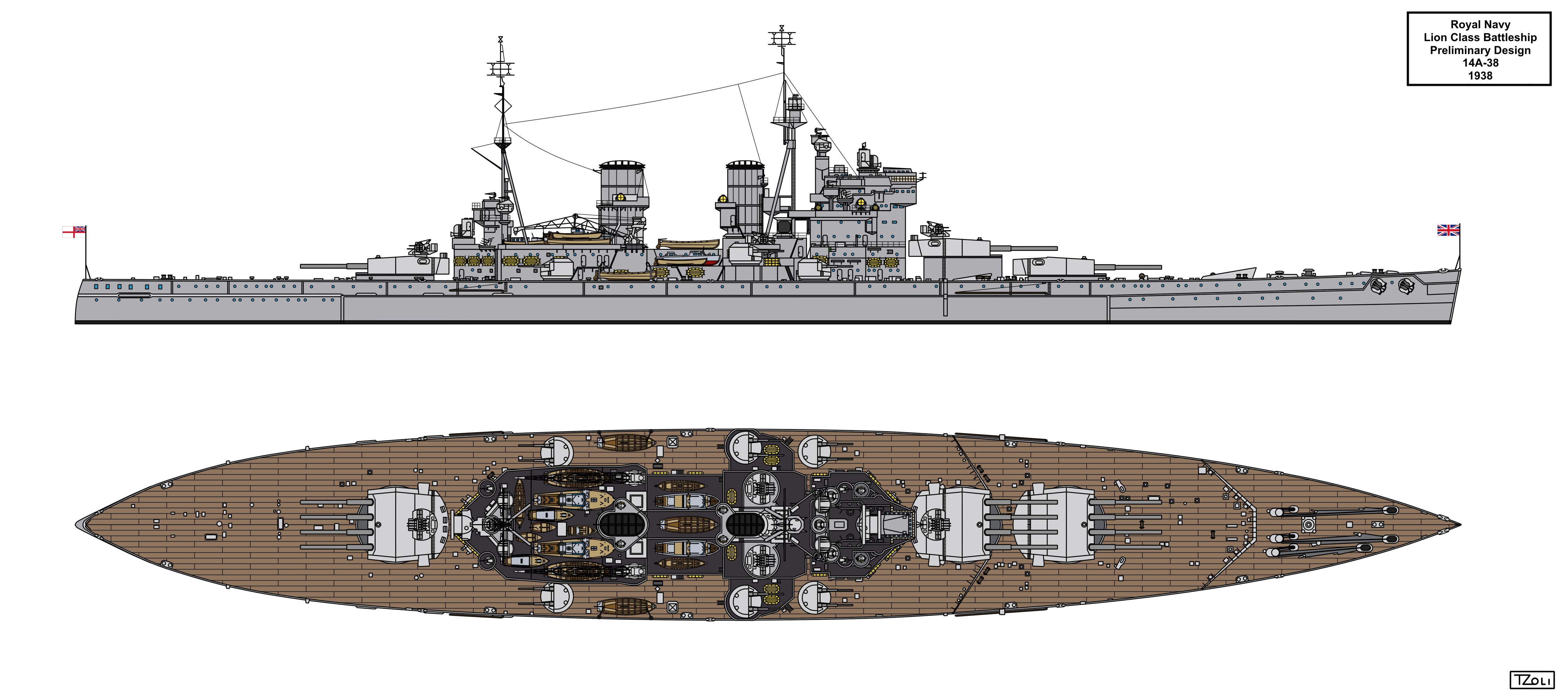
This is the first actual sketch design which led to the Lion class Battleships. Created in late 1937 the earlier proposals were mostly only studies and I could not find data about them except 5 variants considered after KGV: 3x4 14", 3x3 15" and 4x2, 2x3 or 3x3 16" but serious calculations and drawings appeared only from the 2nd half of 1937 and early 1938.
The first designs are strictly modified KGV's to abide the 2nd LNT so on around 35.000tons standard displacement which partly a result to finish the last 3 King George V class battleships to a modified design (3 quad 14" was preferred for them) but eventually evolved into the long postponed and cancelled Lion class battleships.
This particular design is a quad armed 14" gun version of the King George V class, but to remain within the standards of the previous class's tonnage the sacrifice of all aircraft arrangements as well as a pair of 5,25" turrets was necessary to provide enough tonnage for a 3rd quad 14" turret with slightly reduced armour thicknesses on the hull.
The design had these characteristics:
Dimensions: 213,4m(pp), 225,56m(wl), 227,1m (oa) x 31,4m x 9,3m (same as KGV)
Displacement: 35.450tons (Standard), 41.300tons (full load)
Engines: 120.000shp Parsons Steam Turbines
Speed: 53km/h (28knots)
Range: 26.000km at 18-19km/h (14000nm at 10knots)
Armour: 124mm, Deck over machinery and 149mm over magazines, 348mm Belt over machinery and 374mm over magazines.
Armaments:
3x4 14"/45 (356mm/45) BL Mk VII Cannons,
6x2 5,25"/50 (133mm/50) QF Mk I DP-AA Guns,
4x8 40mm/39 Pom-Pom AA Guns
possible 2-4-8x4 12,7mm MG Mk III AA Guns
Sensor suite:
1x Type 79 Air-search Radar on the aft mast
1x Type 273 Surface search Radar on the mainmast above the forward secondary director
2x Type 281 Air-warning Radar on top of the aft mast
4x Type 282 Fire-control Radar sets one for each Pom-Pom director
3x Type 284 Fire-control Radar on the main armament director/rangefinders
4x Type 285 Fire-control Radar sets one for each secondary armament director/rangefinder
2x Type 290 Air-warning Radar on top of the masts
Design 16A-38
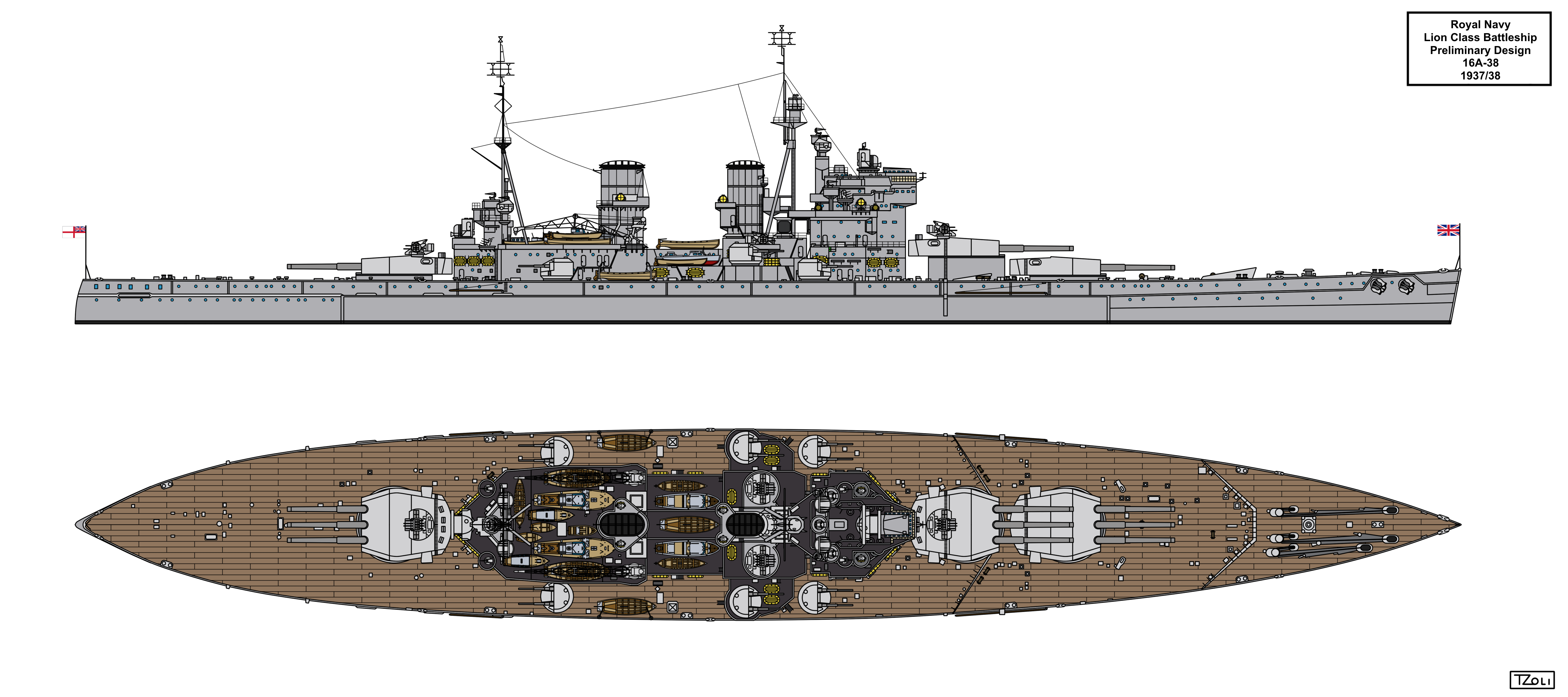
Roughly at the same time the 3 quad 14" armed design was sketched up and worked, a similar design too was proposed but with new triple 16" gun turrets (the 16" armed KGV preliminaries of 1935 would had used the same guns as Nelson's 16") squeezed in the same hull and on a very similar tonnage. To remain in the 35.000tons limit of the 2nd LNT, for standard displacement less ammo was calculated which saved precious tons (there was enough space for a full set of ammo) and similarly to the 14A-37 variant, aircraft facilities and one pair of 5,25 DP-AA gun turrets had to be sacrificed.
The designs had these characteristics:
Dimensions: 213,4m(pp), 225,56m(wl), 227,1m (oa) x 31,4m x 9,3m (same as KGV)
Displacement: 35.540tons (Standard), 41.400tons (full load)
Engines: 110.000shp Parsons Steam Turbines
Speed: 52km/h (28knots)
Range: 26.000km at 18-19km/h (14000nm at 10knots)
Armour: 124mm, Deck over machinery and 149mm over magazines, 348mm Belt over machinery and 374mm over magazines.
Armaments:
3x3 16"/45 (406mm/45) BL Mk II Cannons,
6x2 5,25"/50 (133mm/50) QF Mk I DP-AA Guns,
4x8 40mm/39 Pom-Pom AA Guns
possible 2-4-8x4 12,7mm MG Mk III AA Guns
Sensor suite:
1x Type 79 Air-search Radar on the aft mast
1x Type 273 Surface search Radar on the mainmast above the forward secondary director
2x Type 281 Air-warning Radar on top of the aft mast
4x Type 282 Fire-control Radar sets one for each Pom-Pom director
3x Type 284 Fire-control Radar on the main armament director/rangefinders
4x Type 285 Fire-control Radar sets one for each secondary armament director/rangefinder
2x Type 290 Air-warning Radar on top of the masts
Design 16B-38
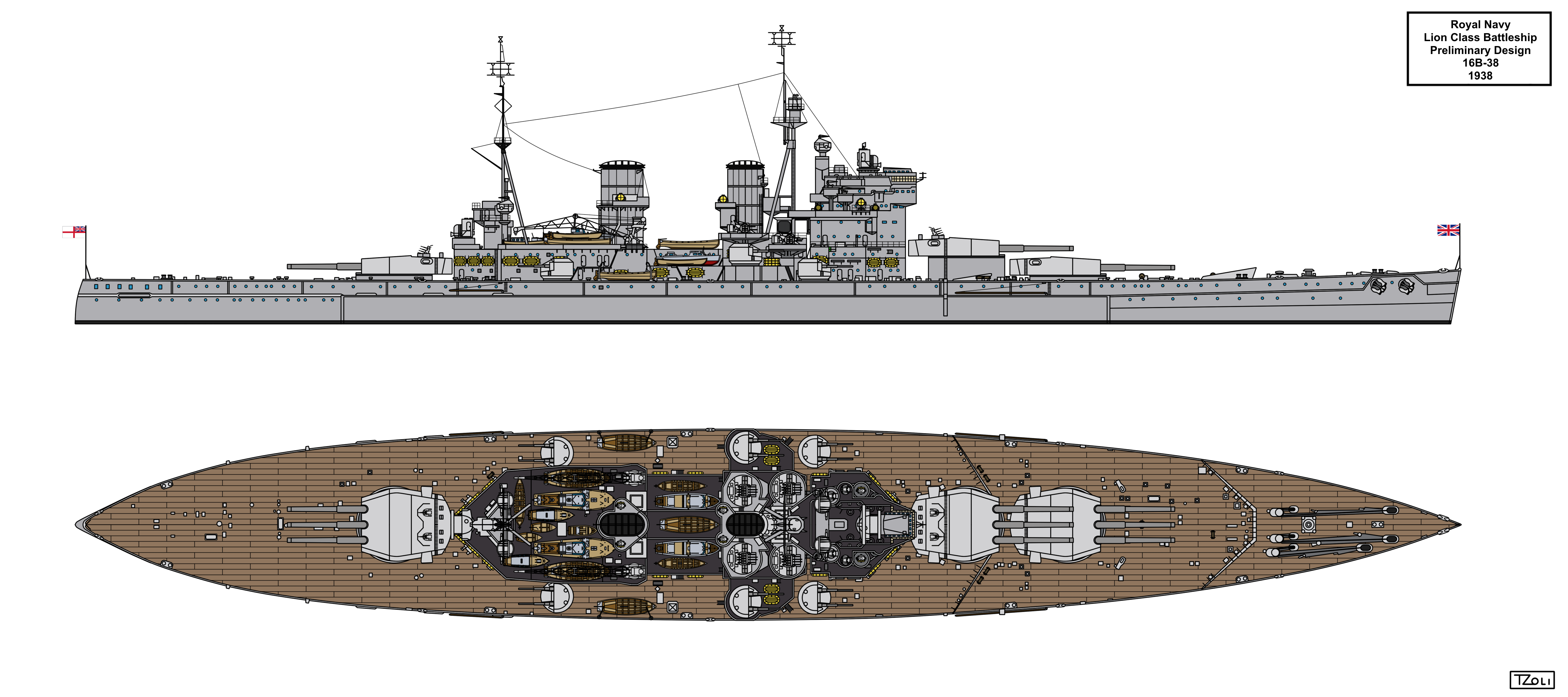
While the designs 14A-37 and 16A-38 was born in late 1937 and late 1937 early 1938 respectively, Design 16B-38 was an early 1938 design, a slight modification of the A version having stated KGV style turbines (with sources differ about increased speed by a knot or not) and 100tons heavier implying a larger engine output. Visually no different then the A-37 version, but I've re arranged the AA armament to make it look somewhat different.
The designs had these characteristics:
Dimensions: 213,4m(pp), 225,56m(wl), 227,1m (oa) x 31,4m x 9,3m (same as KGV)
Displacement: 35.640tons (Standard), 41.500tons (full load)
Engines: 120.000shp Parsons Steam Turbines
Speed: 53km/h (28,5-28,75knots)
Range: 26.000km at 18-19km/h (14000nm at 10knots)
Armour: 124mm, Deck over machinery and 149mm over magazines, 348mm Belt over machinery and 374mm over magazines.
Armaments:
3x3 16"/45 (406mm/45) BL Mk II Cannons,
6x2 5,25"/50 (133mm/50) QF Mk I DP-AA Guns,
4x8 40mm/39 Pom-Pom AA Guns
possible 2-4-8x4 12,7mm MG Mk III AA Guns
Sensor suite:
1x Type 79 Air-search Radar on the aft mast
1x Type 273 Surface search Radar on the mainmast above the forward secondary director
2x Type 281 Air-warning Radar on top of the aft mast
4x Type 282 Fire-control Radar sets one for each Pom-Pom director
3x Type 284 Fire-control Radar on the main armament director/rangefinders
4x Type 285 Fire-control Radar sets one for each secondary armament director/rangefinder
2x Type 290 Air-warning Radar on top of the masts
Design 16C-38
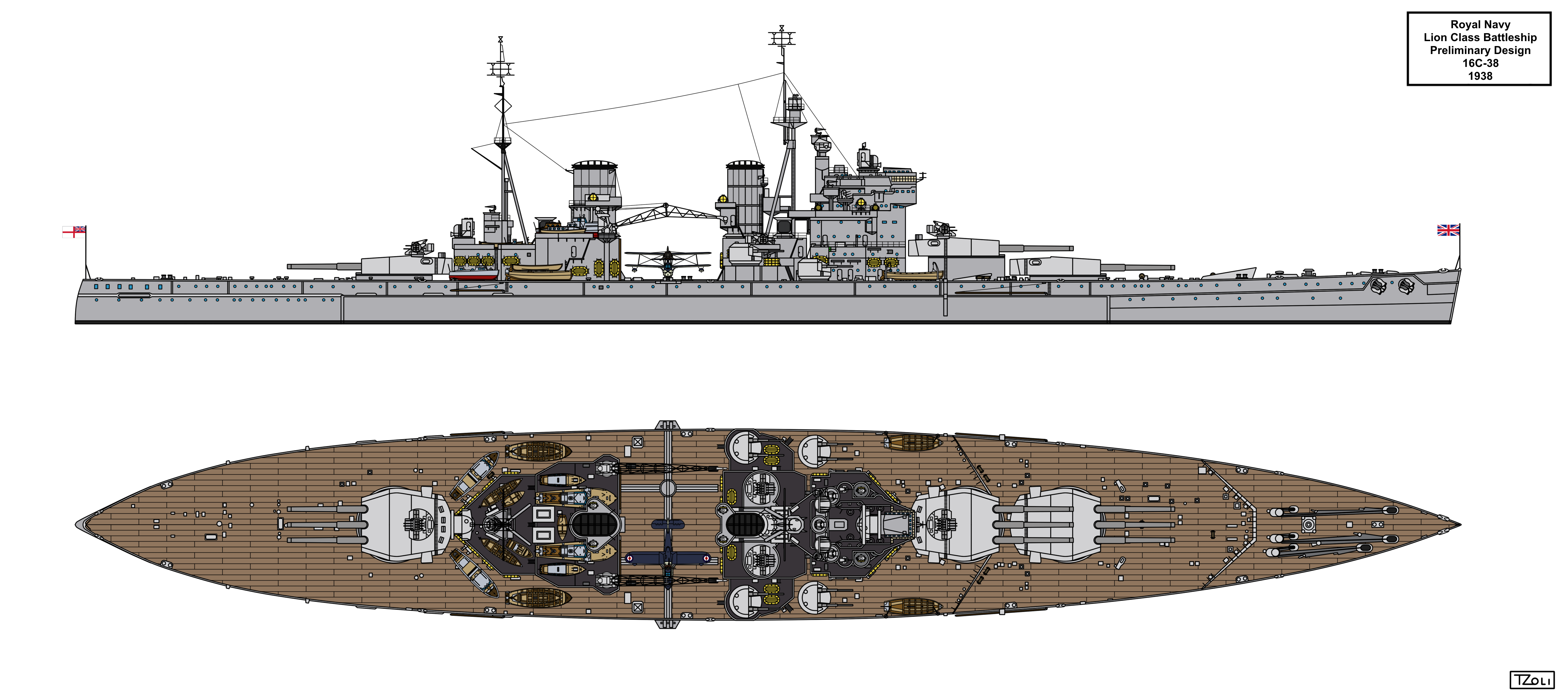
After the 3 designs of the post KGV battleships produced DNC (Director of Naval Constructions) asked to whatever to possible to mount catapults and 2 aircraft on these designs.
Calculations shown that all the aft 5,25" DP-AA guns had to be sacrificed and standard ammo coverage reduced to save enough tonnage to mount the necessary equipment for aircraft handling. What is also unique in the design that the hangers to be located in the after superstructure rather in the middle one (Actually the King George V class battleships had 3 superstructures: The forward one containing the bridge, separated by a short passage from the middle one originally held the hangers and first funnel, and the aft one containing the 2nd funnel and boat storage spaces). The design was not satisfactory enough as it was quite crowded and many of the boats were prone to blast damage from the aft 3rd 16" gun turret when firing! Also the reduced number of Dual Purpose turrets meant reduced long range AA as well as anti destroyer fighting capabilities, especially in night battle. Controller thought if an extra 160tons could be saved somehow (Most likely by altering the protective deck scheme by lowering the armour deck) a pair of 5,25 turrets could be restored, this alternative version would mount all such turrets forward with 2nd superfiring over the other two, but this not only group all secondary guns close to each other and thus danger them to being disable by a single hit but because they had to be moved more forward that the blast of the 2nd triple 16" gun turret would seriously damage the 1st 5,25" mounting!
The designs had these characteristics:
Dimensions: 213,4m(pp), 225,56m(wl), 227,1m (oa) x 31,4m x 9,3m (same as KGV)
Displacement: 35.500tons (Standard), 41.350tons (full load)
Engines: 110.000shp Parsons Steam Turbines
Speed: 52km/h (28knots)
Range: 26.000km at 18-19km/h (14000nm at 10knots)
Armour: 124mm, Deck over machinery and 149mm over magazines, 348mm Belt over machinery and 374mm over magazines.
Armaments:
3x3 16"/45 (406mm/45) BL Mk II Cannons,
4x2 5,25"/50 (133mm/50) QF Mk I DP-AA Guns,
4x8 40mm/39 Pom-Pom AA Guns
possible 2-4-8x4 12,7mm MG Mk III AA Guns.
2x Floatplanes (I've chosen Supermarine Sea Otter)
Sensor suite:
1x Type 79 Air-search Radar on the aft mast
1x Type 273 Surface search Radar on the mainmast above the forward secondary director
2x Type 281 Air-warning Radar on top of the aft mast
4x Type 282 Fire-control Radar sets one for each Pom-Pom director
3x Type 284 Fire-control Radar on the main armament director/rangefinders
5x Type 285 Fire-control Radar sets one for each secondary armament director/rangefinder
2x Type 290 Air-warning Radar on top of the masts
Design 16D-38
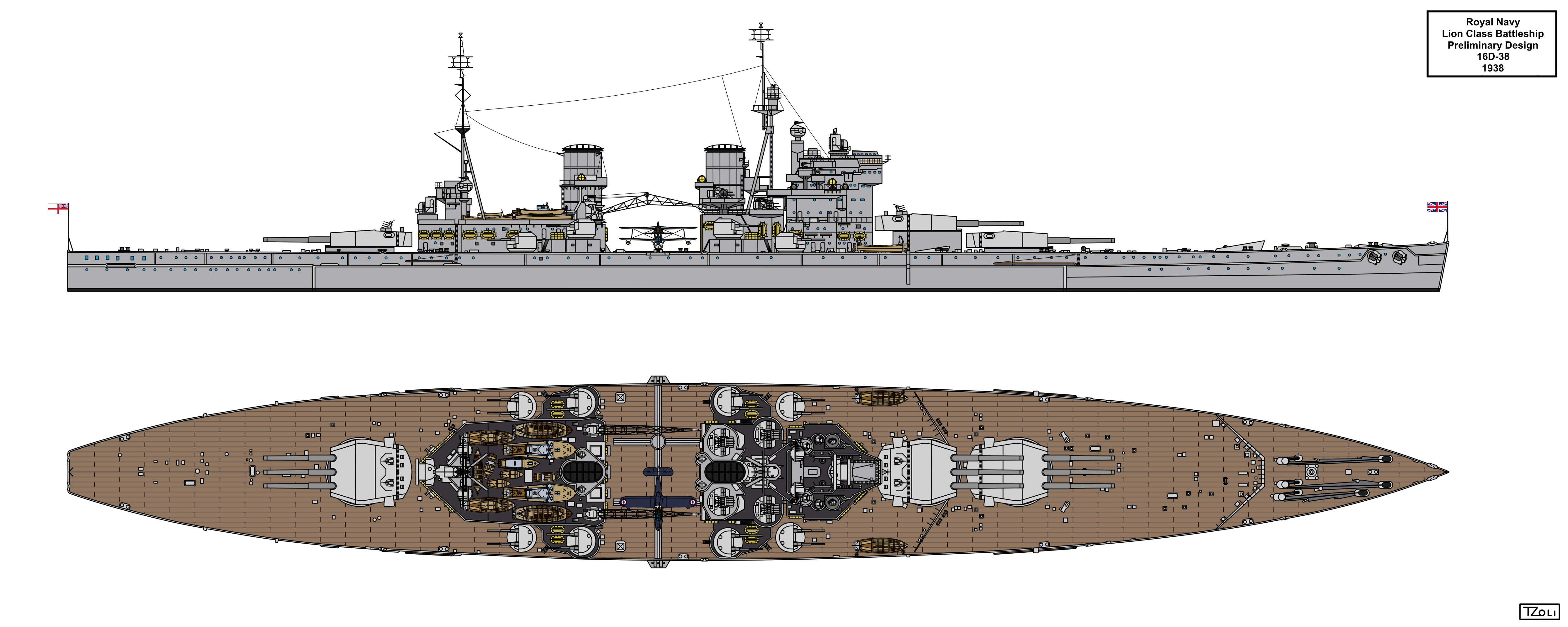
After the previous series was done the Admirality discussed them, the lowered deck armour level as well as the diamond arrangement of he pom-pom AA guns was discarded, also the eventual lifting of the 35.000ton treaty limited invoked by the retire of the Japanese, caused the escalator cause to be fully applied. Resulting in larger warship designs and soon led to the final Lion class battleship design. At first the RN wanted to stay at 40.000tons to keep cost down but soon realised that a balanced 16" armed battleship was better achieved on 45.000tons standard displacement.
This D variant was faster 30knot version of the previous series with all the aircraft, catapult and DP-AA guns retained which together with the increased speed meant a much larger warship as well.
Later a further enlarged version with 4 turrets are proposed designated 16E-38 featuring an even larger hull but a well balanced ship.
The designs had these characteristics:
Dimensions: 250m(wl) x 32,31m x 10,16m
Displacement: 42.500tons (Standard), 48.400tons (full load)
Engines: 150.000shp Parsons Steam Turbines
Speed: 57km/h (30knots)
Range: 26.000km at 18-19km/h (14000nm at 10knots)
Armour: 124mm, Deck over machinery and 149mm over magazines, 348mm Belt over machinery and 374mm over magazines.
Armaments:
3x3 16"/45 (406mm/45) BL Mk II Cannons,
8x2 5,25"/50 (133mm/50) QF Mk I DP-AA Guns,
4x8 40mm/39 Pom-Pom AA Guns
possible 2-4-8x4 12,7mm MG Mk III AA Guns.
2-4x Floatplanes (I've chosen Supermarine Sea Otter)
Sensor suite:
1x Type 79 Air-search Radar on the aft mast
1x Type 273 Surface search Radar on the mainmast above the forward secondary director
2x Type 281 Air-warning Radar on top of the aft mast
4x Type 282 Fire-control Radar sets one for each Pom-Pom director
3x Type 284 Fire-control Radar on the main armament director/rangefinders
5x Type 285 Fire-control Radar sets one for each secondary armament director/rangefinder
2x Type 290 Air-warning Radar on top of the masts
Design 16E-38
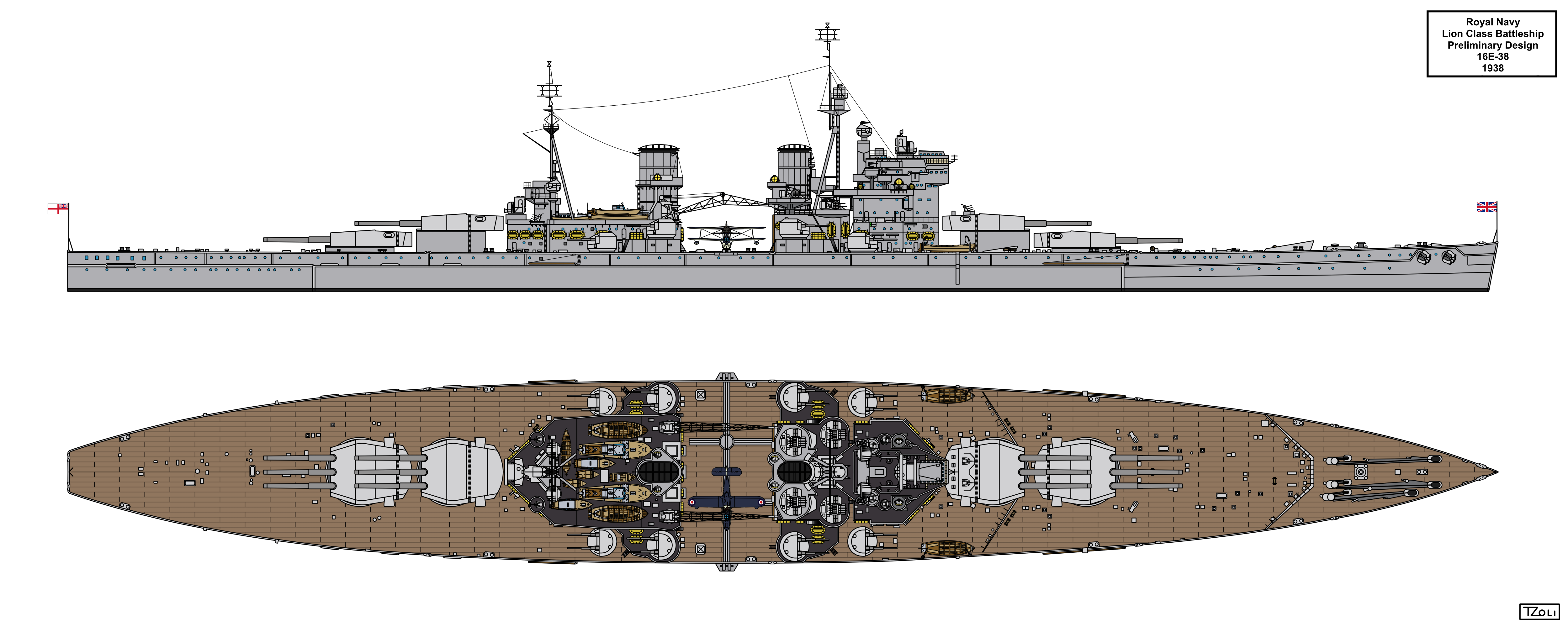
While the previous version was a faster ship taking into account the extra displacement allowed by the escalator clause of the 2nd London Naval Treaty after Japan left it, the E variant was introduced a 4th triple turret increasing the firepower of the design by 25%! Armour remained the same with the same hull form introduced in the D version which helped maintain speed despite the increased displacement. even so the the extra tonnage brought by the 4th turret as well the longer armour belt meant a slower warship altogether, still the admiralty preferred this design for obvious reasons!
In the end it is essentially a British Montana and altogether the 2nd such design of the Royal Navy to mount 12x 16" cannons (the first one was a modified N3 design with 4x3 16" rather 3x3 18" similar in layout to the M2 design both from the 1920's)
The designs had these characteristics:
Dimensions: 259,08m(wl) x 33,53m x 10,72m
Displacement: 48.500tons (Standard), 55.000tons (full load)
Engines: 120.000shp Parsons Steam Turbines
Speed: 48-50km/h (26-27knots)
Range: 26.000km at 18-19km/h (14000nm at 10knots)
Armour: 124mm, Deck over machinery and 149mm over magazines, 348mm Belt over machinery and 374mm over magazines.
Armaments:
4x3 16"/45 (406mm/45) BL Mk II Cannons,
8x2 5,25"/50 (133mm/50) QF Mk I DP-AA Guns,
4x8 40mm/39 Pom-Pom AA Guns
possible 2-4-8x4 12,7mm MG Mk III AA Guns.
2-4x Floatplanes (I've chosen Supermarine Sea Otter)
Sensor suite:
1x Type 79 Air-search Radar on the aft mast
1x Type 273 Surface search Radar on the mainmast above the forward secondary director
2x Type 281 Air-warning Radar on top of the aft mast
4x Type 282 Fire-control Radar sets one for each Pom-Pom director
3x Type 284 Fire-control Radar on the main armament director/rangefinders
4x Type 285 Fire-control Radar sets one for each secondary armament director/rangefinder
2x Type 290 Air-warning Radar on top of the masts
Design 14B-38
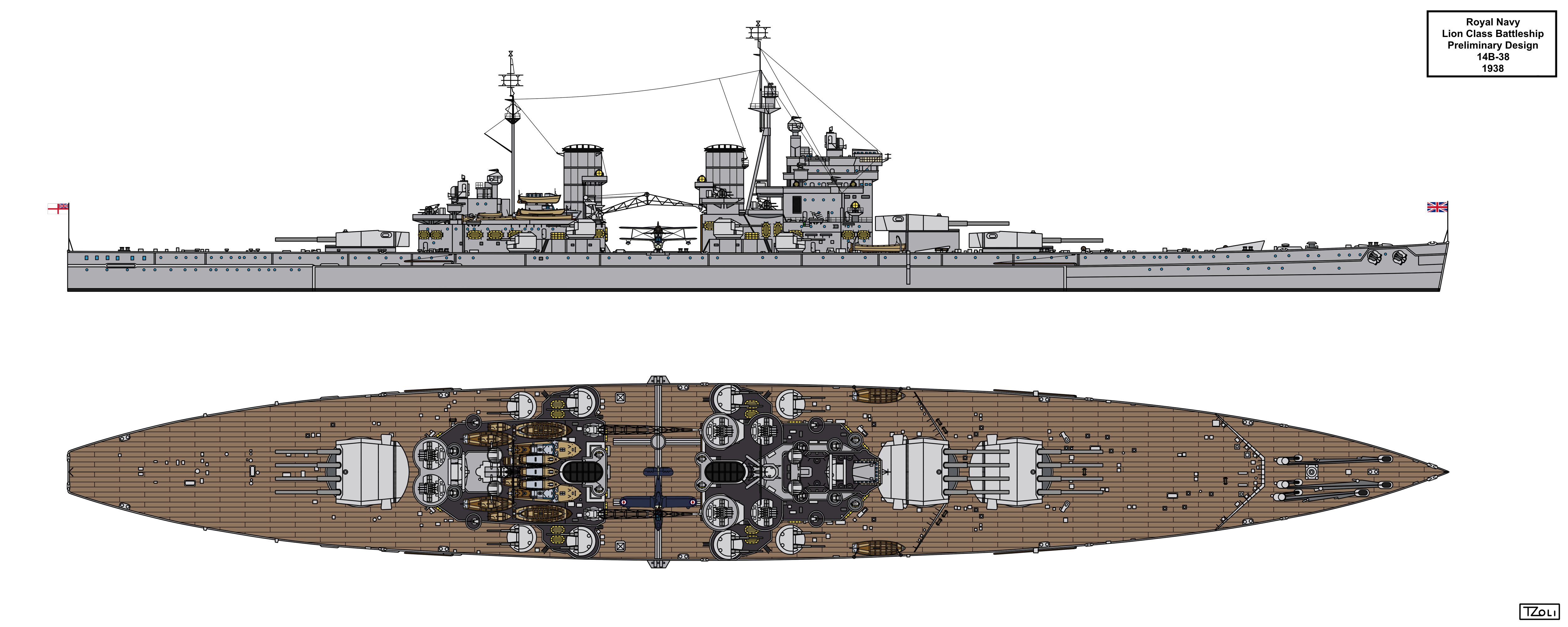
The 14B variant was the logical step of the 14" armed battleship of the Royal Navy after the lifting of the 35.000tons displacement limit of the 2nd London Naval Treaty.
Based on the same hull as the 16D-38 design, this was (to my knowledge) the last 14" armed battleship study of the Royal navy and basically, if you will, can think of as a super King George V class, with improved armament and splinter protection together with a better speed more suited for the Royal Navy, basically as how the KGV should had been built from the first place!
I've chosen more of a Lion stlye superstructure look as well as 40mm Pom-Pom arrangement because this design was created around the same time the final Lion class layout approved.
The designs had these characteristics:
Dimensions: 250m(wl) x 32,31m x 10,16m
Displacement: 42.750tons (Standard), 48.500tons (full load)
Engines: 150.000shp Parsons Steam Turbines
Speed: 56-57km/h (30knots)
Range: 26.000km at 18-19km/h (14000nm at 10knots)
Armour: 124mm, Deck over machinery and 149mm over magazines, 348mm Belt over machinery and 374mm over magazines.
Armaments:
3x4 14"/45 (356mm/45) BL Mk VII Cannons,
8x2 5,25"/50 (133mm/50) QF Mk I DP-AA Guns,
6x8 40mm/39 Pom-Pom AA Guns
possible 2-4-8x4 12,7mm MG Mk III AA Guns.
2-4x Floatplanes (I've chosen Supermarine Sea Otter)
Sensor suite:
1x Type 79 Air-search Radar on the aft mast
1x Type 273 Surface search Radar on the mainmast above the forward secondary director
2x Type 281 Air-warning Radar on top of the aft mast
4x Type 282 Fire-control Radar sets one for each Pom-Pom director
4x Type 284 Fire-control Radar on the main armament director/rangefinders
4x Type 285 Fire-control Radar sets one for each secondary armament director/rangefinder
2x Type 290 Air-warning Radar on top of the masts
Design 16G-38
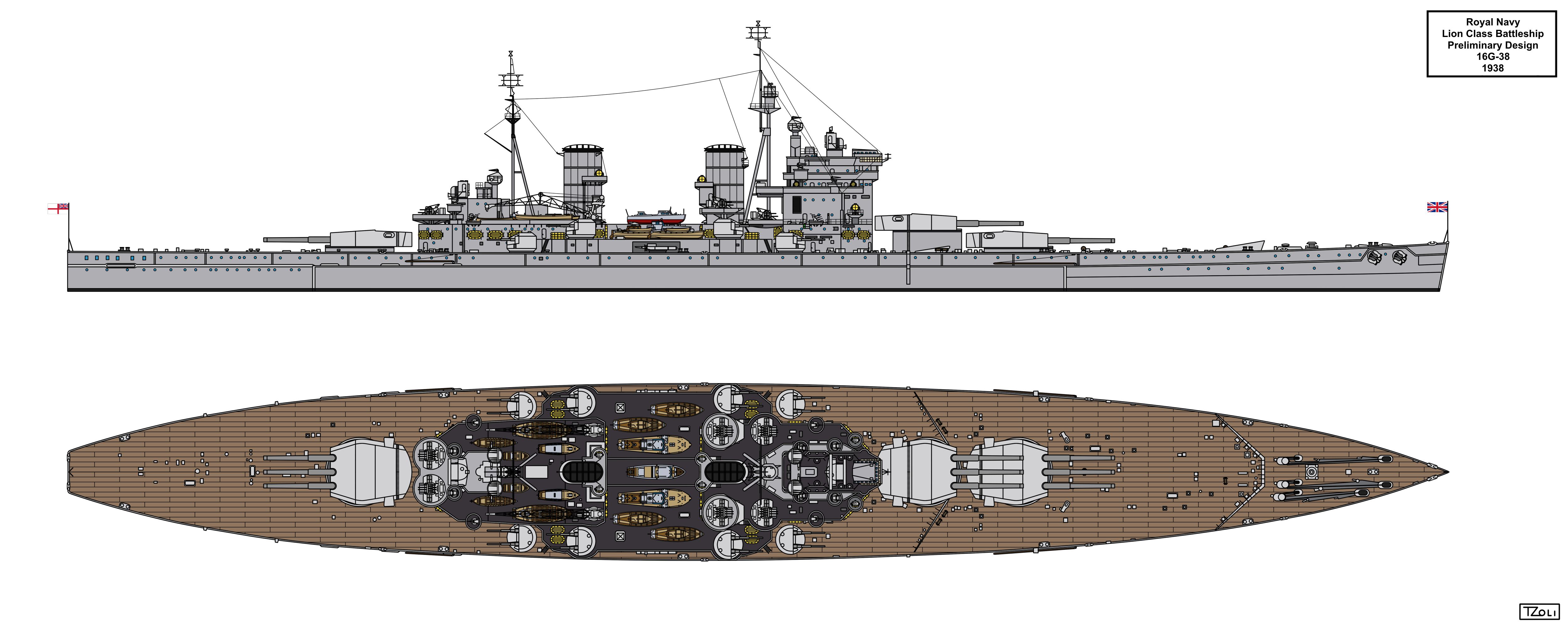
The G version is the last among the 30knotter of Lion pre variants with the same engine as the previous 14B-38 and 16D-38, but what is unique in this design that aircraft facilities was sacrificed for a rather questionable weapon for a battleship:
two quadruple 21" torpedo launchers!
Luckily the final 1938 Lion design discarded this option, on the other hand the idea returned in 1944/45 with the last Lion variants of the RN.
Sources (The two books which actually contains dimensions data as I have no chance of getting to the Brass foundry at Kew in the United Kingdom...) differ about the dimension of this design so I choose the same hull as the 14B-38 and 16D-38
The design had these characteristics:
Dimensions: sources differ: either 240,79 (pp) 250m(wl) or 259,18m (wl) x 32,31m x 9,45m
Displacement: 43.000tons (Standard), 49.000tons (full load)
Engines: 150.000shp Parsons Steam Turbines
Speed: 57km/h (30knots)
Range: 26.000km at 18-19km/h (14000nm at 10knots)
Armour: 124mm, Deck over machinery and 149mm over magazines, 348mm Belt over machinery and 374mm over magazines.
Armaments:
3x3 16"/45 (406mm/45) BL Mk II Cannons,
8x2 5,25"/50 (133mm/50) QF Mk I DP-AA Guns,
6x8 40mm/39 Pom-Pom AA Guns,
possible 2-4-8x4 12,7mm MG Mk III AA Guns,
2x4 21" (533mm) Torpedo Tubes.
Sensor suite:
1x Type 79 Air-search Radar on the aft mast
1x Type 273 Surface search Radar on the mainmast above the forward secondary director
2x Type 281 Air-warning Radar on top of the aft mast
6x Type 282 Fire-control Radar sets one for each Pom-Pom director
3x Type 284 Fire-control Radar on the main armament director/rangefinders
4x Type 285 Fire-control Radar sets one for each secondary armament director/rangefinder
2x Type 290 Air-warning Radar on top of the masts
Design 16F-38
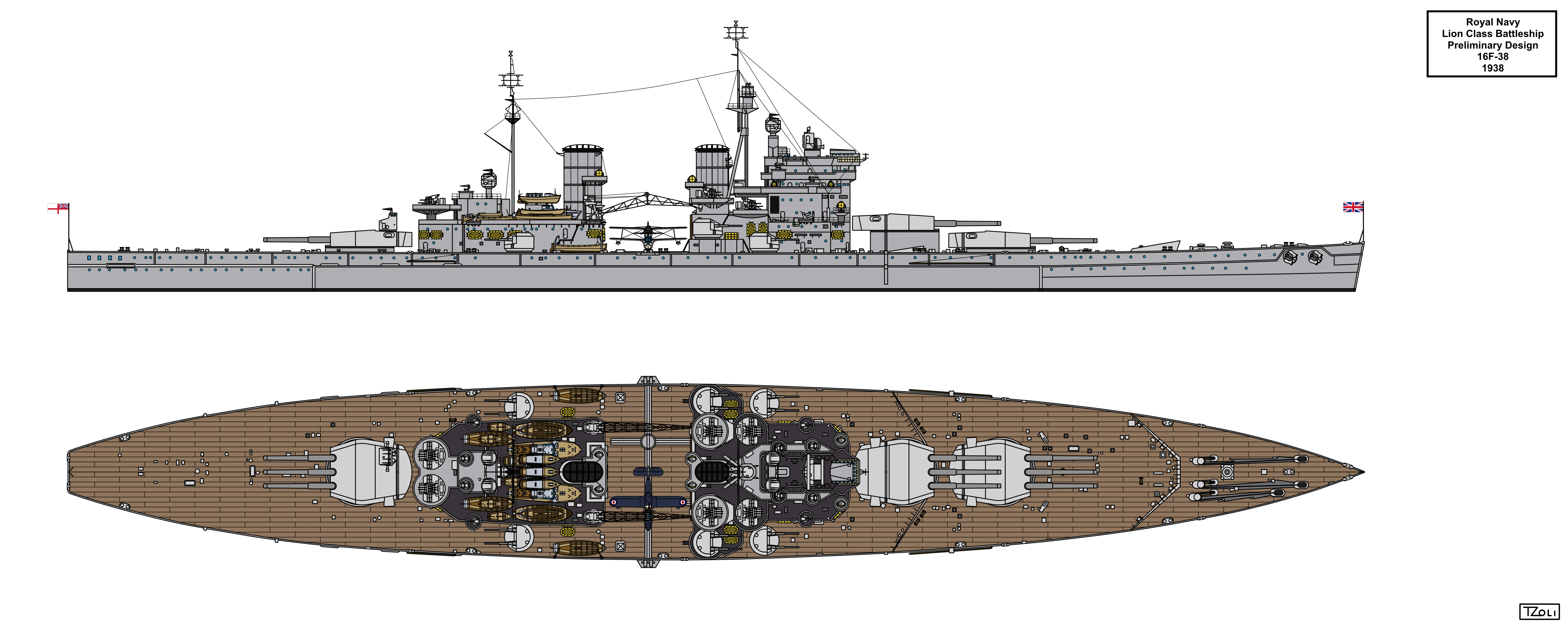
Together with the G variant, the F version too was considered as the final contender for the Lion class battleships to be laid down. While G was faster the sacrifice of the aircraft facilities and the inclusion of the torpedo tubes, was not considered good enough for the increased displacement and hence cost of the design.
The F version was a smaller and slower variant with only 6 twin 5,25" DP-AA guns but fully restored aircraft facilities. DNC finally choose this design but wanted to include the full DP-AA suite and thus a soon a modified version was created with increased powerplant, slightly larger hull and full DP-AA suite including an uniform belt armour.
The design had these characteristics:
Dimensions: 222,5 (pp) 234,7m(wl) x 32m x 9,98m
Displacement: 39.500tons (Standard), 45.200tons (full load)
Engines: 120.000shp Parsons Steam Turbines
Speed: 52km/h (28knots)
Range: 26.000km at 18-19km/h (14000nm at 10knots)
Armour: 124mm, Deck over machinery and 149mm over magazines, 348mm Belt over machinery and 374mm over magazines.
Armaments:
3x3 16"/45 (406mm/45) BL Mk II Cannons,
6x2 5,25"/50 (133mm/50) QF Mk I DP-AA Guns,
6x8 40mm/39 Pom-Pom AA Guns,
possible 2-4-8x4 12,7mm MG Mk III AA Guns,
2-4x Floatplanes (I've chosen Supermarine Sea Otter)
Sensor suite:
1x Type 79 Air-search Radar on the aft mast
1x Type 273 Surface search Radar on the mainmast above the forward secondary director
2x Type 281 Air-warning Radar on top of the aft mast
6x Type 282 Fire-control Radar sets one for each Pom-Pom director
2x Type 284 Fire-control Radar on the main armament director/rangefinder
5x Type 285 Fire-control Radar sets one for each secondary armament director/rangefinder
2x Type 290 Air-warning Radar on top of the masts
Design 16F-38 Modified
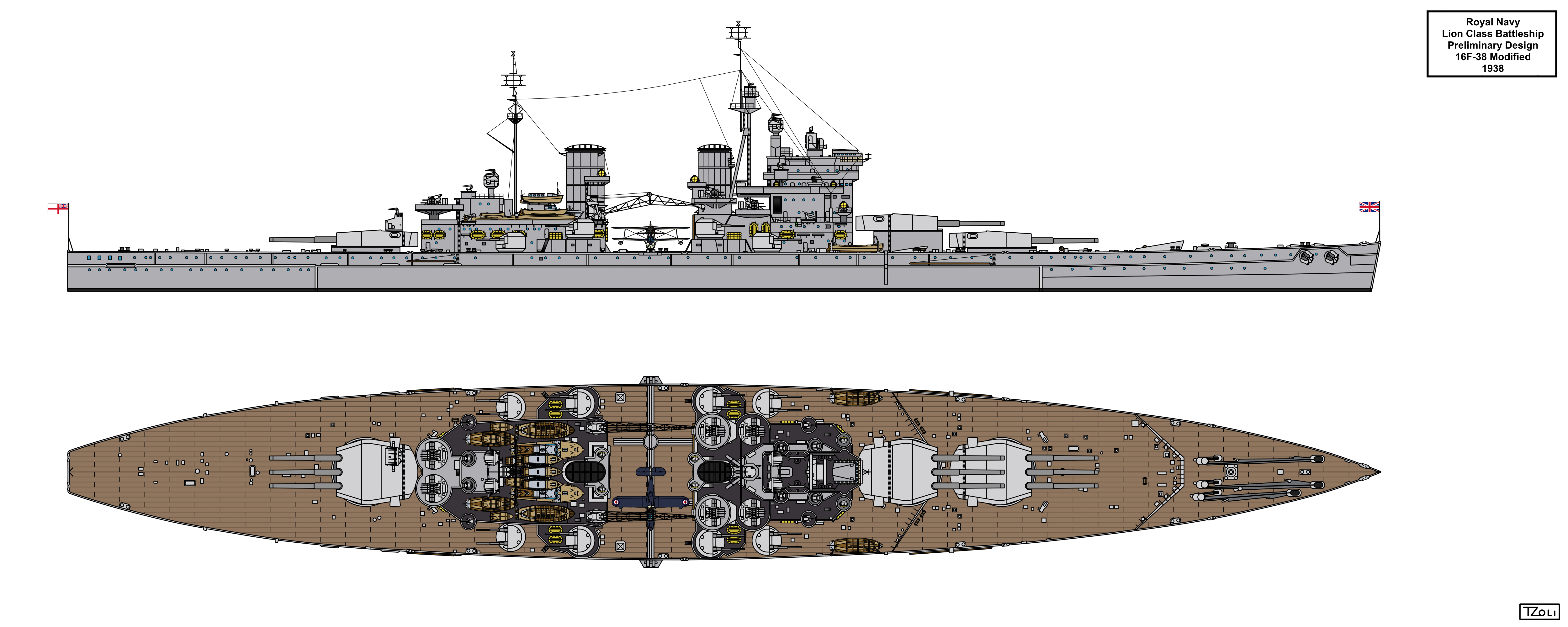
Soon after the F and G versions offered to the DNC, they decided that the F version was overall better and choose to further develop it.
Controller asked what would it cost to reinstall the full DP-AA suite, increase the standard ammo storage from 60 to 80 for the main guns, and the increase of the amidships belt armour to a uniform 374mm, and increase Barbette armour to 15" from 13"
The barbette armour increase and the extra ammo costed 500tons, the further 2 DP-AA guns another 500tons. with a slight increase in length allowed the same speed to be retained.
Though detailed design work meant that the increase is less then expected but the extra belt armour added more and thus engine power had to be increased slightly to 130.000shp, resulting in a slight increase in speed as well.
The design had these characteristics:
Dimensions: 225,55 (pp) 237,74m(wl), 239,3m (oa) x 32m x 10,16m
Displacement: 40.500tons (Standard)
Engines: 130.000shp Parsons Steam Turbines
Speed: 55-56km/h (30knots)
Range: 26.000km at 18-19km/h (14000nm at 10knots)
Armour: 124mm, Deck over machinery and 149mm over magazines, 374mm over machinery and magazines.
Armaments:
3x3 16"/45 (406mm/45) BL Mk II Cannons,
8x2 5,25"/50 (133mm/50) QF Mk I DP-AA Guns,
6x8 40mm/39 Pom-Pom AA Guns,
possible 2-4-8x4 12,7mm MG Mk III AA Guns,
2-4x Floatplanes (I've chosen Supermarine Sea Otter)
Sensor suite:
1x Type 79 Air-search Radar on the aft mast
1x Type 273 Surface search Radar on the mainmast above the forward secondary director
2x Type 281 Air-warning Radar on top of the aft mast
6x Type 282 Fire-control Radar sets one for each Pom-Pom director
2x Type 284 Fire-control Radar on the main armament director/rangefinder
5x Type 285 Fire-control Radar sets one for each secondary armament director/rangefinder
2x Type 290 Air-warning Radar on top of the masts
Final Design 1938/39
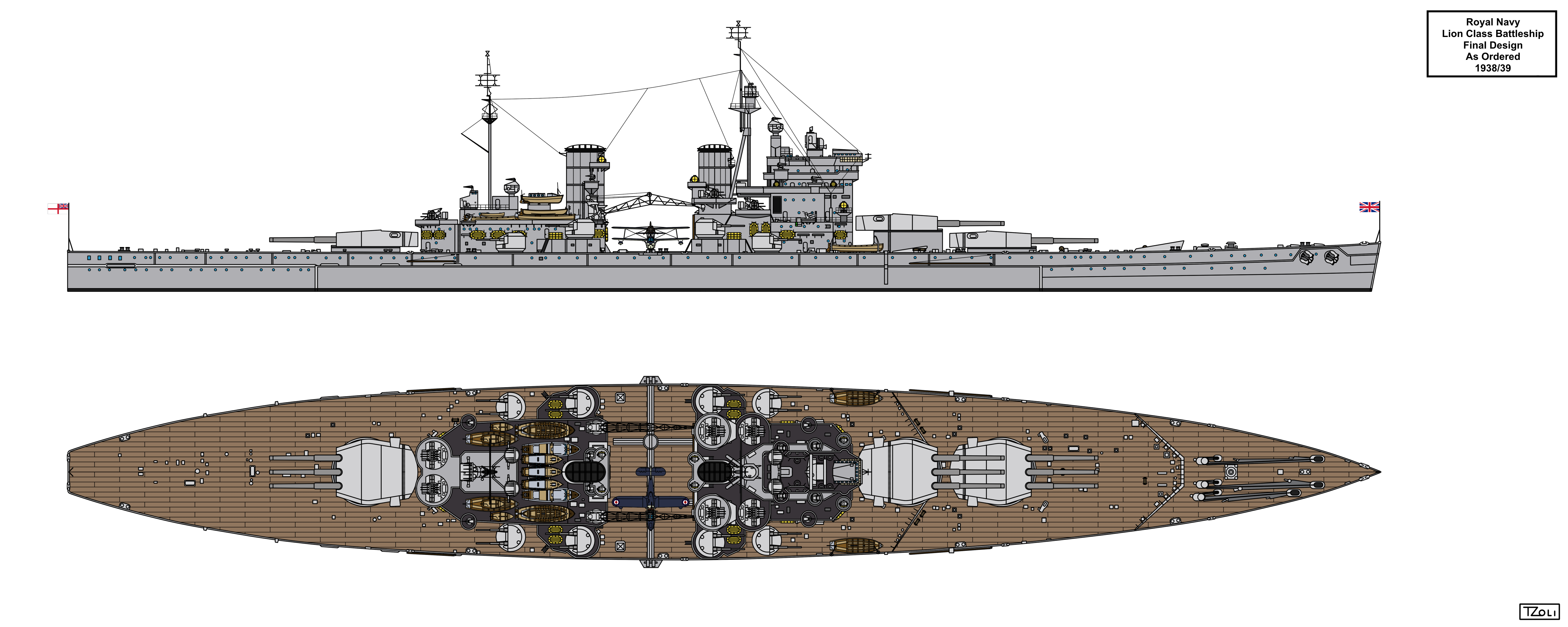
This is the final design of the Lion class Battleships, a modified version of the previous one with rearranging the aft main gun and secondary gun directors and rangefinders with slight changes to the 40mm Pom-Pom placement as well. Otherwise this was how the Lions would had been finished if construction commenced during WW2.
The designs had these characteristics:
Dimensions: 225,55 (pp) 237,74m(wl), 239,3m (oa) x 32m x 10,16m
Displacement: 40.750tons (Standard), 46.000tons (full load)
Engines: 130.000shp Parsons Steam Turbines
Speed: 55-56km/h (30knots)
Range: 26.000km at 18-19km/h (14000nm at 10knots)
Armour: 124mm, Deck over machinery and 149mm over magazines, 374mm over machinery and magazines.
Armaments:
3x3 16"/45 (406mm/45) BL Mk II Cannons,
8x2 5,25"/50 (133mm/50) QF Mk I DP-AA Guns,
6x8 40mm/39 Pom-Pom AA Guns,
possible 2-4-8x4 12,7mm MG Mk III AA Guns,
2-4x Floatplanes (I've chosen Supermarine Sea Otter)
Sensor suite:
1x Type 79 Air-search Radar on the aft mast
1x Type 273 Surface search Radar on the mainmast above the forward secondary director
2x Type 281 Air-warning Radar on top of the aft mast
6x Type 282 Fire-control Radar sets one for each Pom-Pom director
2x Type 284 Fire-control Radar on the main armament director/rangefinder
5x Type 285 Fire-control Radar sets one for each secondary armament director/rangefinder
2x Type 290 Air-warning Radar on top of the masts

